The release note describes the various new features and enhancements carried out in Version 2.0 Build 11 of PrognoCIS™; with the specifications and UI details wherever applicable.
Following enhancements are done on Patient Reminder popup ( invoked from the Patient Reminder link on Home page) :
The screen is divided into two sections, first section allows selection of criteria for filtering results, and the second section displays the results of selected filter. Refer to figure 2.1-1
Figure 2.1-1 : Patient Reminder popup
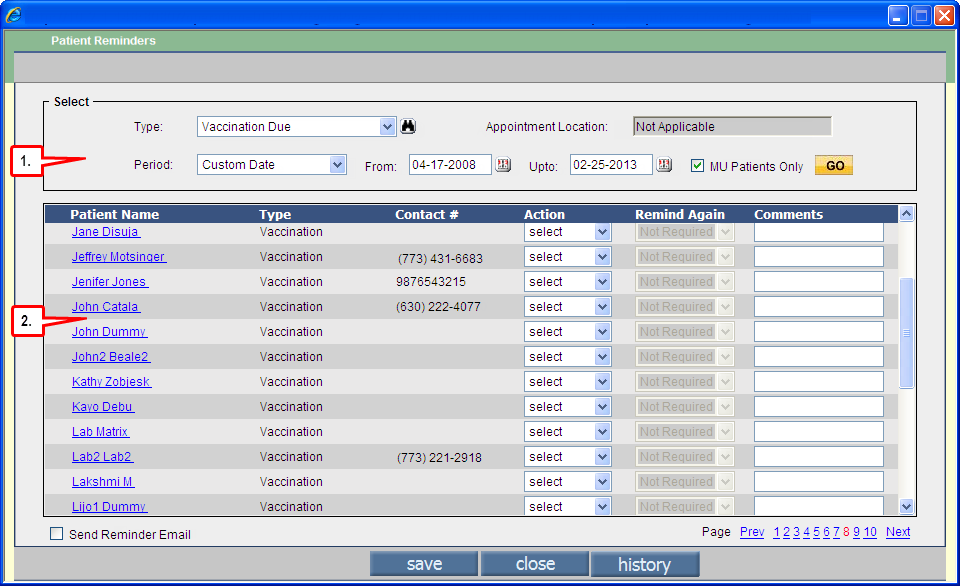
- Section 1:
• The field, Type is now a drop-down list with additionally six new options available for selection namely, All; Upcoming Appointment; Appointments To be Confirmed; Appointments To be Rescheduled; Wait Listed Appointments; and Requested Appointments. Refer to the following figure 2.1-2
Figure 2.1-2 : Patient Reminder popup : section 1 with Type field with options
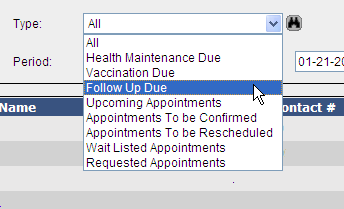
Note: Search is available ONLY for options, Health Maintenance Due and Vaccination Due.
• A new field, Appointment Location has been added that displays the various available appointment locations, Refer to the following figure 2.1-3. The field remains 'Not Applicable' for types such as All; Health Maintenance Due; Vaccination Due; and Follow Up Due.
Figure 2.1-3 : Patient Reminder popup : section 1 with Appointment Location field
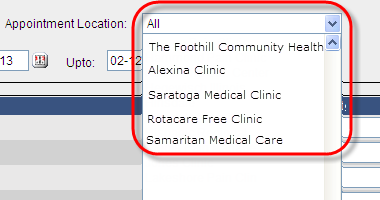
![]() Note: Appointment Location field is not applicable for Health Maintenance Due ; Follow Up Appointment Due ; and Vaccination Due
Note: Appointment Location field is not applicable for Health Maintenance Due ; Follow Up Appointment Due ; and Vaccination Due
• A new field, Period has been added that allows User to give an approximate period of time to be considered in the filter. Refer the following figure 2.1-4
Figure 2.1-4 : Patient Reminder popup : section 1 with Period field
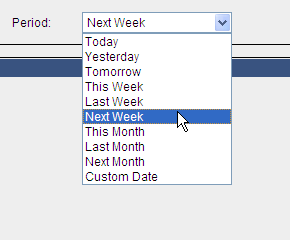
• The fields, From and Upto allow Users to give a Date range. Refer to the following figure 2.1-5
Figure 2.1-5 : Patient Reminder popup : section 1 with fields to enter start and end date
![]()
Note: If a User selects date from the fields, From and Upto then the Period field gets set to ‘Custom Date'.
• The option, MU Patients only displays search results for Patient's who qualify the Meaningful Use measure. The option remains enabled only for Patient Reminder Type- Health Maintenance Due, Follow-Up Due; and Vaccination Due.
• On click on the button,
the respective results for the filter applied are displayed in Section 2. Refer to the following figure 2.1-6
- Section 2:
Figure 2.1-6 : Section 2 displaying records as per the selected criteria in section 1
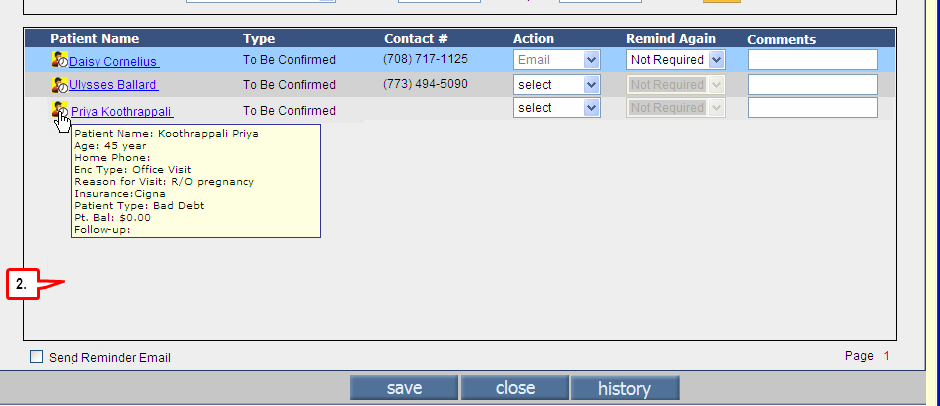
• The list displays in columns, the Patient Name; Type (includes All, Upcoming Appointment, To be Confirmed Appointment, To be Rescheduled Appointment, and Wait List Appointment); Contact Number (Patient’s Primary Contact Number); Action; Remind Again and Comments.
• The Appointment icon:
displays patient's appointment details.It is available only for appointment related types (types such as Upcoming Appointments; Appointments to be confirmed; Appointments to be Rescheduled; and Requested Appointments). Refer to figure 2.1-6
• The Patient Name link on click displays the patient's reminder history details. Refer to figure 2.1-7
Figure 2.1-7 : Patient's reminder history displayed
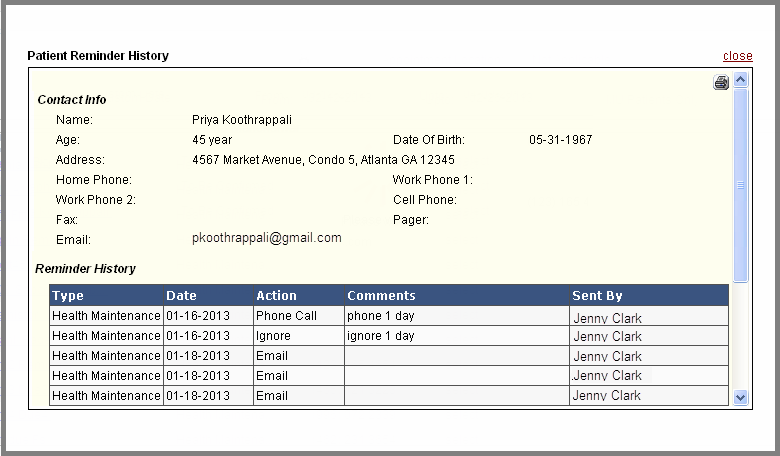
• The Action drop-down menu displays a list of ‘action' that has to be taken with respect to the type of reminders. Refer to the following figure 2.1-8
Figure 2.1-8 : Action drop-down menu displays a list of ‘action'
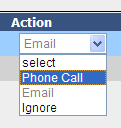
• The Remind Again drop-down menu displays the number of days after which the reminder should be displayed again. Refer to the following figure 2.1-9
Figure 2.1-9 : Remind Again in days and weeks
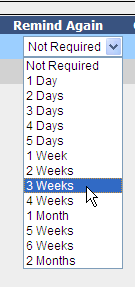
• The option, Send Reminder Email when selected selects Email as the ‘Action’ value in the Action drop-down menu only for patients having a registered email id and on Save a reminder email is sent to the respective patient. Refer to the following figure 2.1-10
Figure 2.1-10 : Send Reminder Email checbox to send mail to patient
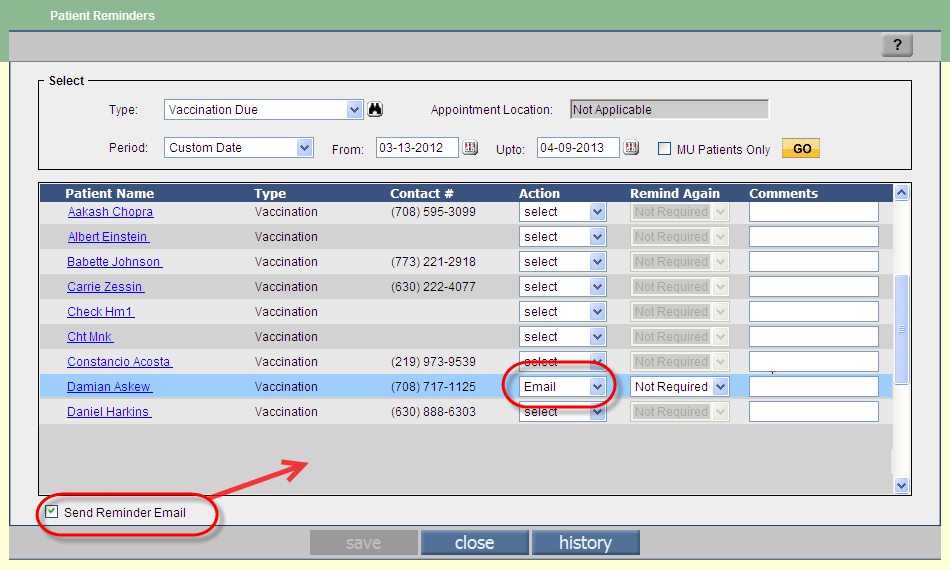
![]() Note: The Send Reminder Email option is NOT available for ‘Wait Listed' and ‘Requested' appointments
Note: The Send Reminder Email option is NOT available for ‘Wait Listed' and ‘Requested' appointments
• On click on the history button a Patient Search popup is invoked wherein User can select any Patient other than on list displayed to view Patient's Reminder History, Refer to the figure 2.1-7
• It is now possible to keep patients in a Wait list, for appointment dates that are currently unavailable but may become available in case of a no show appointment or for any other reason.
• Consider the scenario; a patient calls up the Clinic for an appointment of 3rd January, the Clinic staff looks up the Appointment Schedule screen and finds that all the appointments for the day have been taken and the earliest date when appointment can be scheduled is 8th January. The Clinic staff informs the patient, that a confirmed appointment for the Patient can be scheduled for the 8th of January, and the Patient can be added on Wait list for an appointment
on 3rd January.
If the Patient agrees then the Clinic staff clicks the Wait List button to schedule a Wait List Appointment for the Patient. Refer to the following figure 3.1-1
Figure 3.1-1 : Popup to schedule a Wait List Appointment for the Patient

![]() Note: Following are the conditions applicable for a Wait list Appointment:
Note: Following are the conditions applicable for a Wait list Appointment:
- Wait list appointment date should be greater than current date.
- Wait list appointment date should be less than the appointment date.
- Up to Preferred Time should be greater than the From Preferred Time.
• Wait list detail when entered is indicated with a white checkmark on the button along with the appointment date and time details alongside in red,Refer to the following figurefigure 3.1-2
Figure 3.1-2 : Wait list button with a white checkmark

• Patients added in the Wait List are viewed from the Call List section of Appointment Schedule screen; a new option, ‘Wait List’ has been added. Refer to the following figure 3.1-3
Figure 3.1-3 : Call List section of Appointment Schedule screen
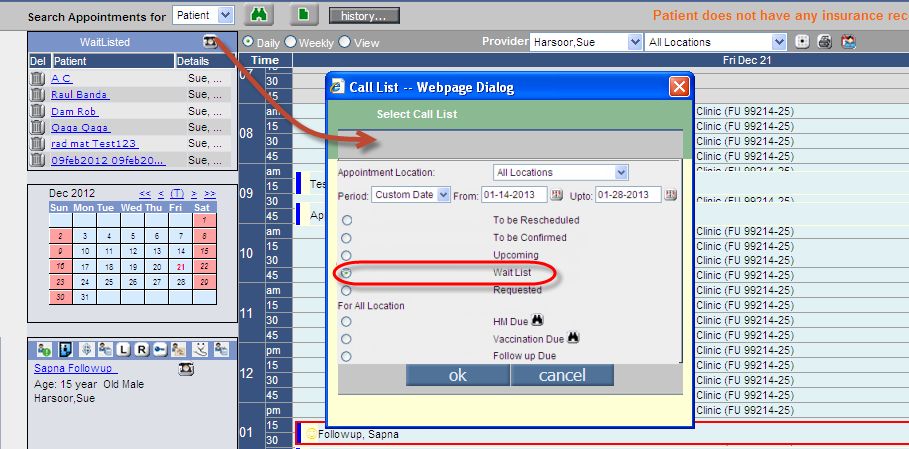
![]() Note:
Note:
- In case of recurring appointment, patient will be added in the wait list of base appointment. Associated recurring appointments do not have any wait list details.
- Under following conditions a Wait List appointment is cleared automatically from the list:
- When an Wait List appointment is marked as ‘Arrived’
- When an appointment is marked as ‘No Show’
- When an appointment is cancelled by Clinic
- When an appointment is cancelled by Patient
- Wait List is not available for Appointment Type, ‘Others’; the Wait List button becomes disabled.
- If rescheduled appointment date is less than Wait List appointment date then wait list automatically gets cleared.
- A tabular report List of patients in wait list appointment has been added explicitly to list out wait listed appointments of patients.
- Wait list appointment cannot be taken for the same day as scheduled appointment.
Navigation: GoTo tab: Appointment → Schedule → History button → Patient Search popup → Appointment History popup . Refer to the following figure 3.2-1
Figure 3.2-1 : Appointment History popup

• Three new columns have been added, their details are as follows:
- Wait List Details - Displays the Date and Preferred Time of Appointment.
- Status Comment - Displays the details added in the Comments field on Patient Workflow popup.
- Case Number - Displays the
associated Worker's Compensation case number.
- The From and Up to columns of Appointment History popup now displays time in AM and PM only.
• Appointment History now has a new icon:![]()
Navigation: GoTo tab: Appointment → Schedule → click on Call List icon:![]() → Call List popup. Refer to the following figure 3.3-1
→ Call List popup. Refer to the following figure 3.3-1
Figure 3.3-1 : Image displaying Enhanced Call List popup

• A new field, Appointment Location has been added that displays the various available appointment locations, Refer to the following figure 3.3-2
Figure 3.3-2: Image displaying Appointment Location field

![]() Note: Appointment Location field is not applicable for Health Maintenance Due ; Follow Up Appointment Due ; and Vaccination Due
Note: Appointment Location field is not applicable for Health Maintenance Due ; Follow Up Appointment Due ; and Vaccination Due
• A new field, Period has been added that allows User to give an approximate period of time to be considered in the filter. Refer to the following figure 3.3-3
Figure 3.3-3: Image displaying the Period field

• The fields, From and Upto allow Users to give a Date range, Refer to the following figure 3.3-4
Figure 3.3-4: Image displaying fields to enter start and end date
![]()
• Two new options, 'Wait Listed Appointments' (to display wait listed appointments) and 'Requested Appointments' (to display appointments requested by patients via portal - details given further) have been additionally added in the popup, Refer to the following figure 3.3-1
• The Clinic location details for a Provider are available on the Block Time popup.
• Depending upon the location (All or specific) selected for a Provider, the details are displayed accordingly. Refer to the following figures 3.4-1 and 3.4-2
Figure 3.4-1: Specific location details for a Provider as seen on Block time popup
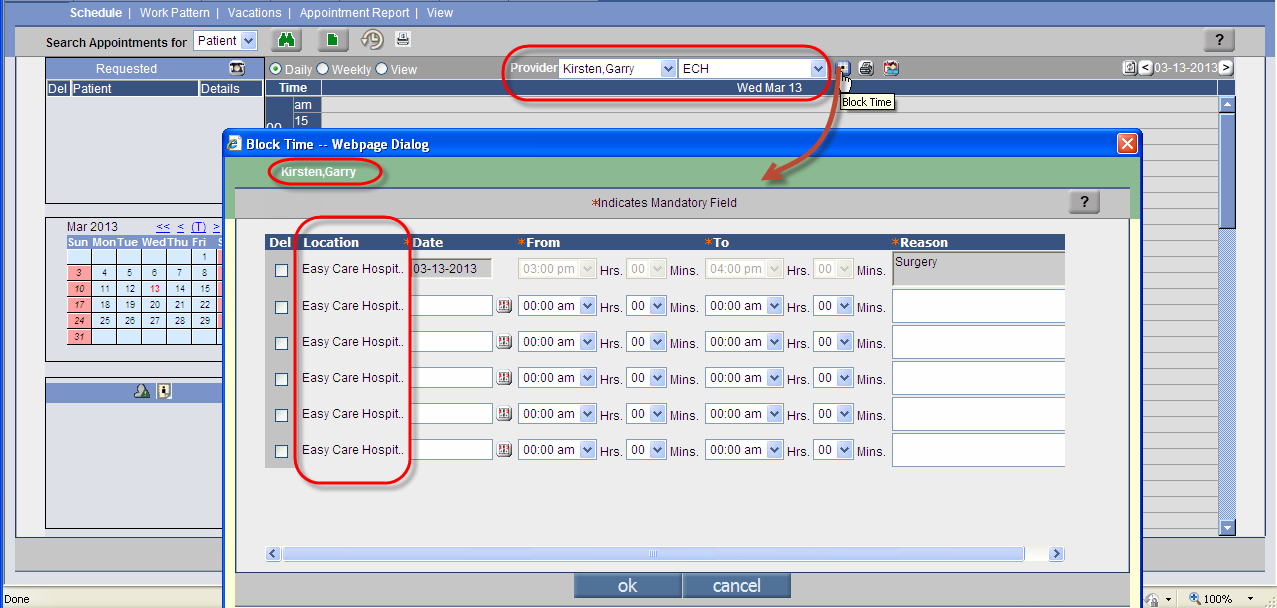
Figure 3.4-2: ALL location details for a Provider as seen on Block time popup
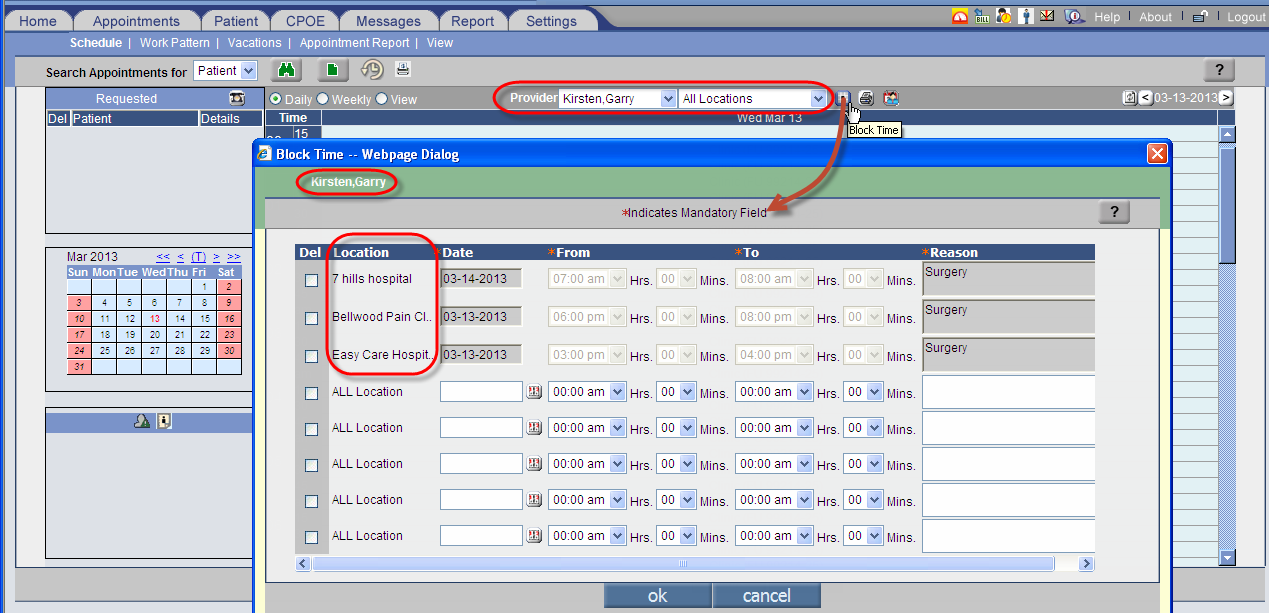
Introduction:
Case Management Feature in PrognoCIS has been designed as a multi-purpose screen for tracking various types of cases, emphasizing more on Injury cases.
Injury or accident cases are generally of Workers Comp type or Auto Accident type or Personal Accident type. One Injury or Accident of a patient is generally one Case and needs to be tracked by the clinic, Insurance, Employer, Case Managers, Attorneys, Adjusters, etc. Work Comp Insurances need Progress Notes, Work Status Reports, PR1, PR2, PR4, etc. with every claim sent for a Work Comp Injury patient. Hence, generally, Providers want to track all visits of a patient for a Case very carefully and document progress and status appropriately. Billers want easy access to all documents and transactions related to a Patient Case so that they can send documents along with claims and avoid Claims rejections. The new Case Management feature introduced in PrognoCIS will satisfy all these requirements.
In addition to that, the Case Management feature can be used as a tracking feature for other cases or scenarios for tracking or comparing certain Patient Visits done Vs Approved or Amounts Billed Vs Approved by associating Case number to those visits.
Two Scenarios supported for Case Management:
Till now, to keep data separate for each Case, especially Workers Comp Case, same patient was defined multiple times, one for each injury case. Now, with the Case concept introduced, there will be no need to add same patient again and again just to keep injury wise documents separate.
Scenarios:
1. One-to-Many (One Patient-Multiple Cases- Case Wise Visits-Default)
2. One-to-One (One Patient-One Case- New Patient Per Case-Property: Y)
1. One-to-Many: With the ability to assign a case to a visit, users will be able to easily filter the documents per case. This can be achieved by Scenario 1 below: One-To-Many.
2. One-to-One: If clinics want to continue to define one patient per Injury Case, they will be able to achieve this by Scenario 2: One-to-One. For switching to Scenario 2, one property will have to be turned ON as shown below.
Following property setting decides whether for a clinic, Scenario 1 or 2 will be in effect.
Property: patient.allow.one.case : N
Help: If this property is set to Y, only one Case will be allowed for one patient registered. For every new case, a new patient will have to be added. By default, setting will be N, allowing multiple cases for same Patient.
Property: patient.use.case.management.search : N
Help: If set to Y, additional 3 fields will be shown in Patient Searches: Case No, Date of Injury, Body Part. This will be used only for One-To-One setting i.e where one case for one patient is allowed and same patient has to be defined multiple times.
Case Management popup. Refer to the following figure 4.1-2, the Case Management icon: ![]() is available on the Registration screen, User fills in Case Management details in the popup invoked.
is available on the Registration screen, User fills in Case Management details in the popup invoked.
Figure 4.1-2: Case Management Popup

![]() Note:
Note:
- The case management icon changes to red color when there is an existing case.
- Case Management Details entered are not copied to copy record. The popup is available with blank fields each time a record is copied.
- Portal login credentials are NOT created for records copied as new Patients in Worker's Comp scenario, as the copied record is a child of originally registered Patient record (parent)
- If a PrognoCIS TMUser updates Patient's information (e.g. First Name/Last Name/DOB etc) from any of the copied (child) record then system treats the updated Patient record separate from its parent record and delinks it. For a de-linked record, separate credentials of Patient Portal (User Id and Password) are created – as system treats it as independent Patient record.
- Originally created Patient record cannot be deleted if it has copied records still associated with it. Following alert is displayed to User. Refer to the following figure 4.1-3.
Figure 4.1-3: Dialog box displaying alert message
Points ii to viii are applicable to both Case ‘One to One' and Case ‘One to Many'
ii. On Appointment Schedule popup,
Clinical staff selects the Worker's Comp patient → Selects the relevant Case number form the Case No. field. → Fills in the other details and schedules the appointment. Refer to the following figure 4.1-6
Figure 4.1-6: Case Number field as displayed on Appointment Schedule popup
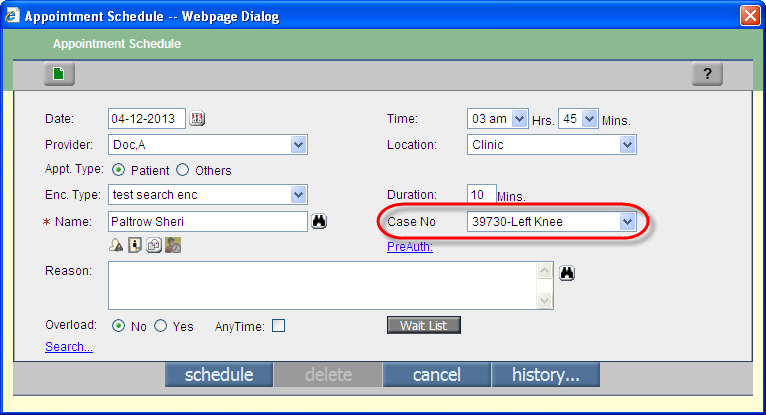
![]() Note:
Note:
-
Case Number drop-down menu is available only if a patient has been selected.
-
The selected Case Number is associated with the Appointment on click on Scheduled button.
- The Appointment tool tip displays the Case Number, Date of Injury, and Body Part.
iii. On Start/Edit Encounter screen, a new field, Case Number has been added to start or edit selective case, Refer to the following figure 4.1-7
Figure 4.1-7: Edit Encounter screen displaying Case Numbers associated to a Patient
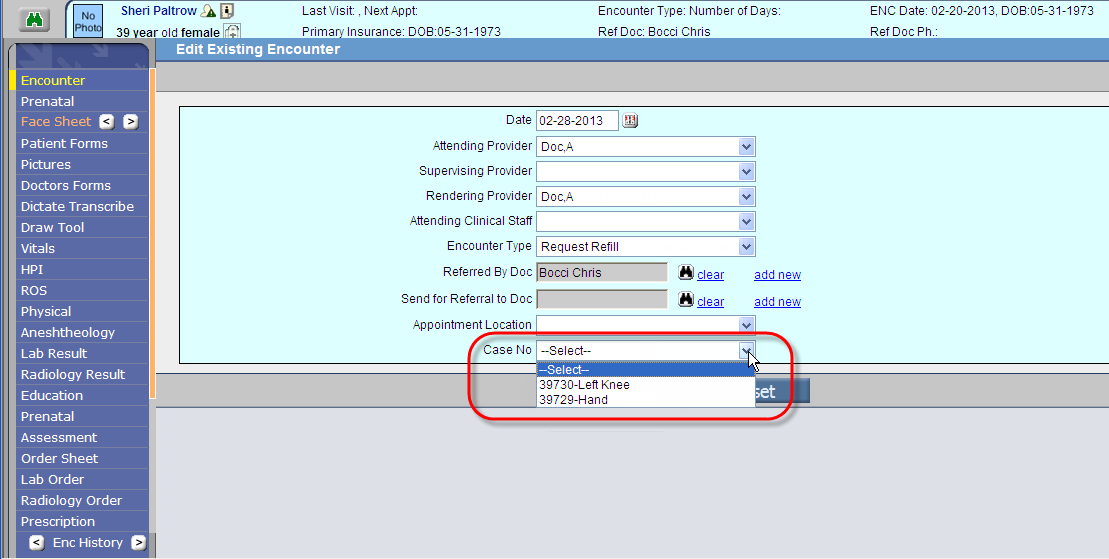
iv. On Encounter screen, Case Management icon:
found on the Patient Band provides easy accessibility to Patient's Case information. Refer to the following figure 4.1-8
Figure 4.1-8: Patient Band displaying Case Management icon
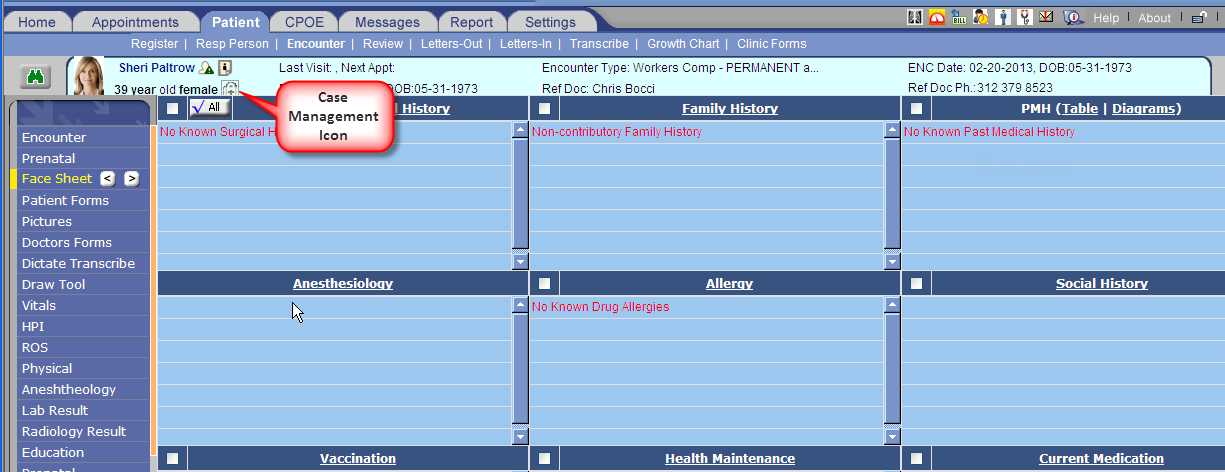
v. On Patient → Letters-Out screen, Case-wise sorting has been made available on the DocView popup (invoked via Attach button) thus case related documents are easily fetched and attached.
Contact list relevant to the Case Number is available in the To drop-down menu,Refer to the following figure 4.1-9
Figure 4.1-9: Relevant Contact list displaying on Patient Letters-Out screen
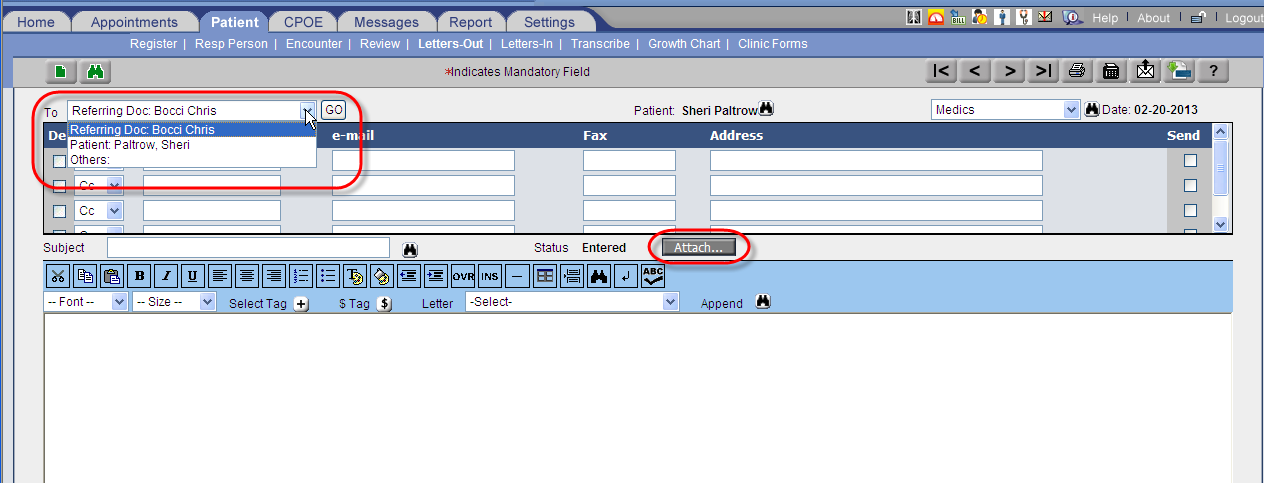
Depending on relevant option present the following information can be displayed:
Table 4.1-1: Table displaying relevant contact list that can be displayed in the To drop-down list if details are present
| Nos. | Relevant Contact List |
|---|---|
1. |
Referring Doc |
2. |
Referred to Doc |
3. |
Rendering Doc |
4. |
Attending Doc |
5. |
Operating Doc |
6. |
Operating Doc1 |
7. |
Operating Doc2 |
8. |
Primary Care Physician 1 |
9. |
Primary Care Physician 2 |
10. |
Primary Care Physician 3 |
11. |
Primary Care Physician 4 |
12. |
Primary Care Physician 5 |
13. |
Patient |
14. |
Emergency Contact |
15. |
Spouse/Legal Guardian |
16. |
Responsible Person |
17. |
Patient Adjuster |
18. |
Patient Attorney |
19. |
Case Insurance Company |
20. |
Case Insurance Subscriber |
21. |
Case Insurance Attorney |
22. |
Case Insurance Adjuster |
23. |
Case Patient Attorney |
24. |
Patient Case Manager 1 |
25. |
Patient Case Manager 2 |
26. |
Patient Case Manager 3 |
27. |
Primary Insurance |
28. |
Subscriber of Primary Insurance |
29. |
Primary Insurance Attorney |
30. |
Primary Insurance Adjuster |
31. |
Secondary Insurance |
32. |
Subscriber of Secondary Insurance |
33. |
Secondary Insurance Attorney |
34. |
Secondary Insurance Adjuster |
35. |
Tertiary Ins Co |
36. |
Subscriber of Tertiary Insurance |
37. |
Tertiary Insurance Attorney |
38. |
Tertiary Insurance Adjuster |
39. |
Employer |
40. |
Others |
vi. On Encounter History popup, A new column, Case No. displays the associated case numbers to the Encounters displayed. Refer to the following figure 4.1-10
Figure 4.1-10: Encounter History popup displaying newly added Case No. Column

Note: The Case No. displayed has to be associated to the Patient from the Start Encounter screen.
vii. On Document List screen, a new filter, Documents for Encounters with Case No. has been added specifically to display list of all cases with associated Encounters. On selection of a case number from the drop-down menu, documents that are associated to Encounters with selected Case Number are displayed. Refer to the following figures 4.1-11 and 4.1-12
![]() Note: Documents not associated to an encounter like Other Docs will not be shown in the filtered list.
Note: Documents not associated to an encounter like Other Docs will not be shown in the filtered list.
Figure 4.1-11: New filter available on the Document List –Filter popup

Figure 4.1-11: Filtered list displayed
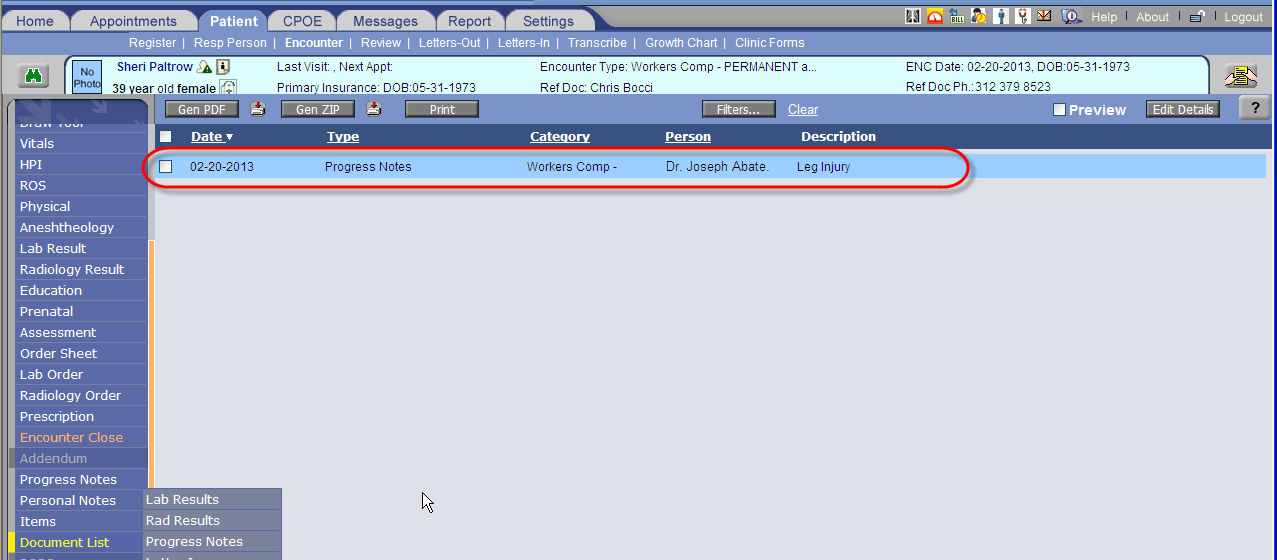
• The ‘registered' Worker's Comp Patients are easily visible on the Patient Search popup. The search has been enhanced to additionally display columns such as Case #; Injury Date; Body Part . Refer to figure 4.1-12. The display of these additional Patient search columns are property based i.e. only if the property, patient.use.case.management.search is set as ‘Y' will the columns be displayed else regular Patient search popup is displayed.
Figure 4.1-12: Patient Search popup with additional columns Case and Body Part
![]() Note: If the property, patient.use.case.management.search is set to ‘Y' then Worker's Comp defined search are also applicable on the following screens - Patient Registration, Encounter, Letter out, Appointment Schedule, Refill; Laboratory; and Radiology via CPOE, Message Compose and Patient Review.
Note: If the property, patient.use.case.management.search is set to ‘Y' then Worker's Comp defined search are also applicable on the following screens - Patient Registration, Encounter, Letter out, Appointment Schedule, Refill; Laboratory; and Radiology via CPOE, Message Compose and Patient Review.
• On Patient Portal, if the Patient record has associated copy or copies of Worker's Comp record registered then a drop down menu, Case Details is displayed listing out the number of cases associated with the Patient as Worker's Compensation. Refer to the following figure 4.1-13
Figure 4.1-13: Patient Portal Screen displaying Case Details drop-down
• To display case number changes in Appointment tool tip, add tag, [CASE_NO] to appointment.tooltip.patient property.
• To display case number changes in Home page tool tip, add tag, [CASE_NO] to home.appt.tooltip.patient property.
• Tags are also added for case management. Refer to the following table 4.1-2
Table 4.1-2: List of tags for added case management
| Nos. | Tags |
|---|---|
1. |
CASE_NO |
2. |
CASE_INJURY_DATE |
3. |
CASE_INJURY_PLACE |
4. |
CASE_INJURY_STATE |
5. |
CASE_BODYPART |
6. |
CASE_STATUS |
7. |
CASE_DATE_1STILLFROM |
8. |
CASE_DATE_1STILLUPTO |
9. |
CASE_DATE_SAMILLNESS |
10. |
CASE_DATE_HOSPFROM |
11. |
CASE_DATE_HOSPUPTO |
12. |
CASE_DATE_NWORKFROM |
13. |
CASE_COMMENT |
14. |
CASE_DATE_NWORKUPTO |
15. |
CASE_DATE_CLOSED |
16. |
CASE_WCAB |
17. |
CASE_QMEPANEL |
18. |
CASE_LIENNOTES |
19. |
CASE_INS_NAME |
20. |
CASE_INS_SUBSCRIBERID |
21. |
CASE_INS_ATTORNEY |
22. |
CASE_INS_ADJUSTER |
23. |
CASE_PAT_ATTORNEY |
24. |
CASE_PAT_ADJUSTER |
25. |
CASE_MANAGER1 |
26. |
CASE_MANAGER2 |
27. |
CASE_MANAGER3 |
28. |
CASE_VISITS_APPROVED |
29. |
CASE_VISITS_ACTUAL |
30. |
CASE_AMOUNT_APPROVED |
31. |
CASE_AMOUNT_ACTUAL |
32. |
CASE_INJURY |
33. |
CASE_DATE |
34. |
CASE_DATE_NWORKUPTO |
35. |
CASE_INS |
36. |
CASE_INS_STATUS |
37. |
CASE_PAT |
38. |
CASE_VISITS |
39. |
CASE_AMOUNT |
40. |
CASE_COMMENT |
41. |
CASE_END |
42. |
Enc Case Past Visit |
43. |
Enc Case Past Visit Desc |
• The Date of Birth field found on the Patient's Other Relation popup (GoTo tab: Patient → Register → Contacts tab → More button) is now editable. User now has the option to either enter date via calendar popup or by manually entering the date in the Date of Birth field, Refer to the following figure 4.2-1
Figure 4.2-1 : Screen displaying a manual entry of date done by User
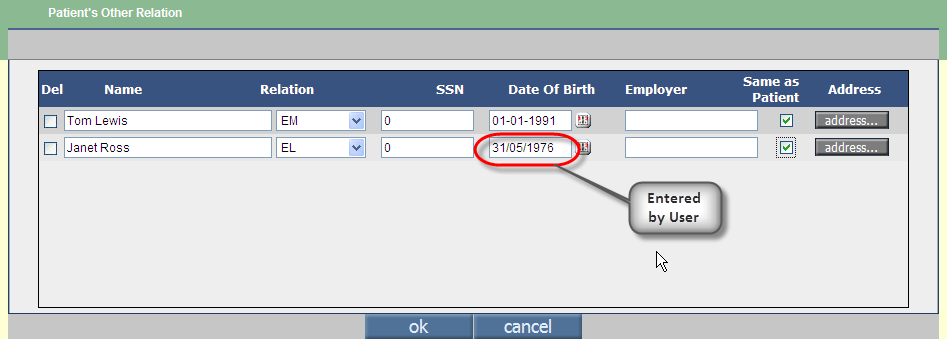
• Login info icon: ![]() now indicates presence of credential details by display of a checkmark in red
now indicates presence of credential details by display of a checkmark in red ![]() .
.
• Encounter icon:![]() is now available on Patient Registration screen. if a User is working on Encounter or Face sheet details of Patient A and then goes to Patient Registration screen to edit registration details of Patient B then on click on the new Encounter icon
is now available on Patient Registration screen. if a User is working on Encounter or Face sheet details of Patient A and then goes to Patient Registration screen to edit registration details of Patient B then on click on the new Encounter icon![]() , system takes the User directly to the last open Encounter or Face sheet details of Patient B.
, system takes the User directly to the last open Encounter or Face sheet details of Patient B.
• The Patient Pharmacy popup (now called as Patient Pharmacy) has the following enhancements done: Refer to the following figure 4.2-2,
- new icon:
 of Patient Pharmacy as seen on Patient Registration screen.
of Patient Pharmacy as seen on Patient Registration screen. - a new column, Telephone is added to display the telephone number of the Pharmacy;
- two additional buttons, Move Up and Move Down are available to set the sequence of the Pharmacies in the list, User selects a row and then brings it one row up at a time with each click on button, Move Up and vice-a-versa with the button, Move Down ;
- the drag-and-drop feature on mouse press has been introduced to move records up and down directly without using the buttons Refer to the following figure 4.2-2
Figure 4.2-2 : The Patient Pharmacy popup displaying the telephone number of the Pharmacy
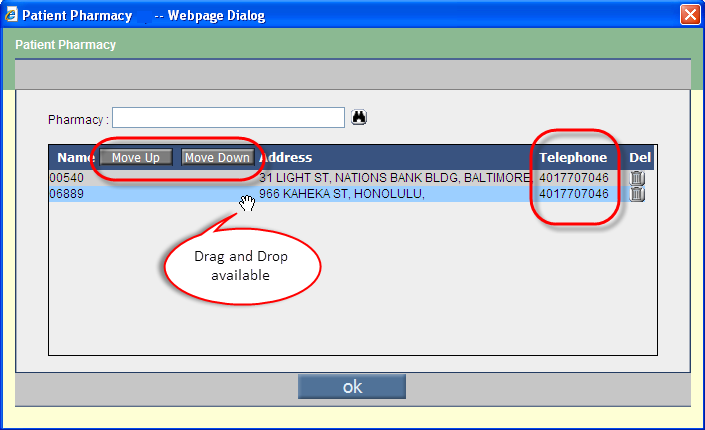
![]() Note: Pharmacies selected from the Pharmacy Vendor popup (invoked via search icon) is added to the list.
Note: Pharmacies selected from the Pharmacy Vendor popup (invoked via search icon) is added to the list.
• If the selected Pharmacy Vendor is eRx enabled then a prefix, ‘ eRx ' is displayed with the Pharmacy name. Refer to the following figure 4.2-3
Figure 4.2-3 : eRx enabled Pharmacy Vendor highlighted with a prefix

![]() Note: Pharmacy icon:
Note: Pharmacy icon: ![]() is displayed in red if User has filled in Pharmacy details
is displayed in red if User has filled in Pharmacy details
• The Label Printer icon is available to print Patient Demographic details, Refer to the following figure 4.2-4
Figure 4.2-4 : Label Printer icon on Patient Register screen
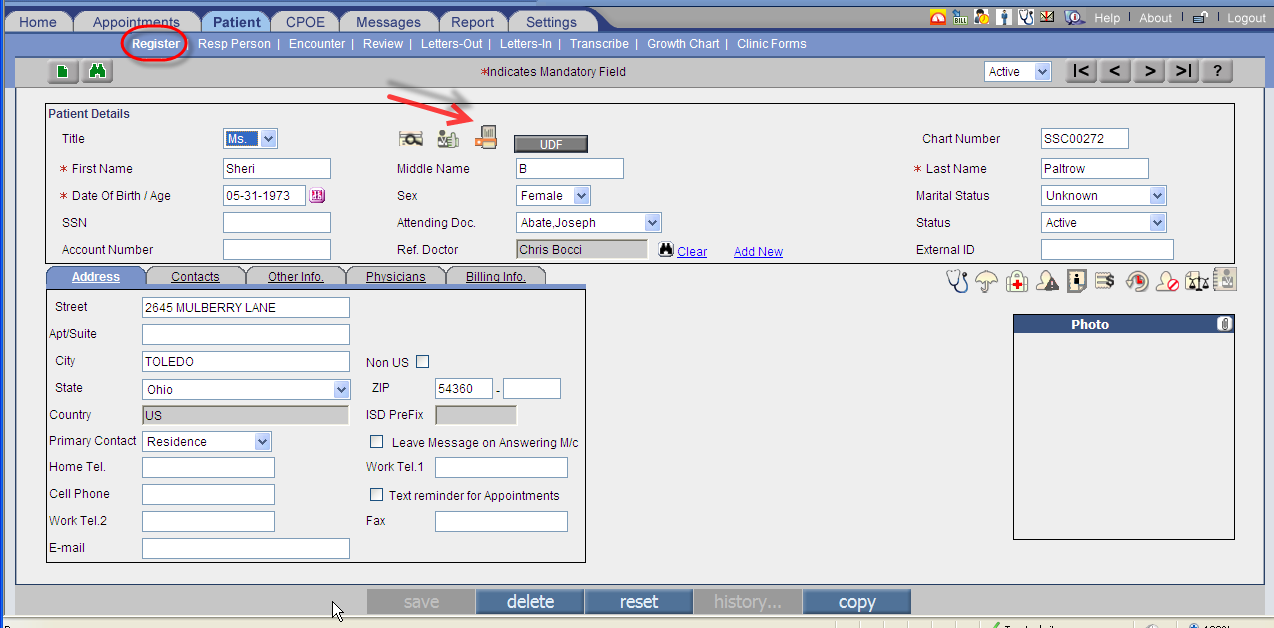
• Sending text messages to Patient's mobile number is now possible in PrognoCIS™.
• A new option, Text reminder for Appointments is made available on the Address tab of Patient Registration screen (tab: Patient → Register) to opt for sending text messages to Patient with respect to reminders for the appointments scheduled. Refer to the following figure 4.3-1
Figure 4.3-1 : Address tab on Registration screen displaying the ‘Text reminder for Appointments' option
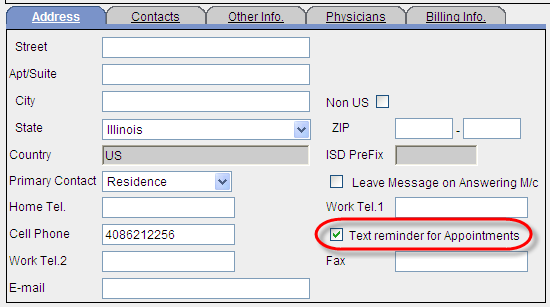
![]() Note:
Note:
- The option remains enabled only if the Clinic has opted for this feature.
- Text reminder does not support non-US address or number; when Non-US option is selected then the Text reminder for Appointments becomes unchecked and disabled.
• To add the text for the reminders following steps have to be followed:
- Navigation – GoTo tab: Settings → Configuration → Templates → link: Email
- On the Template drop-down there is an option, Text Reminder for Appointment Scheduled, on click displays a different screen that are sans HTML controls (different from other Email Templates). Refer to the following figure 4.3-2
Figure 4.3-2 : Screen displaying HTML controls for Text Reminder for Appointment Scheduled template
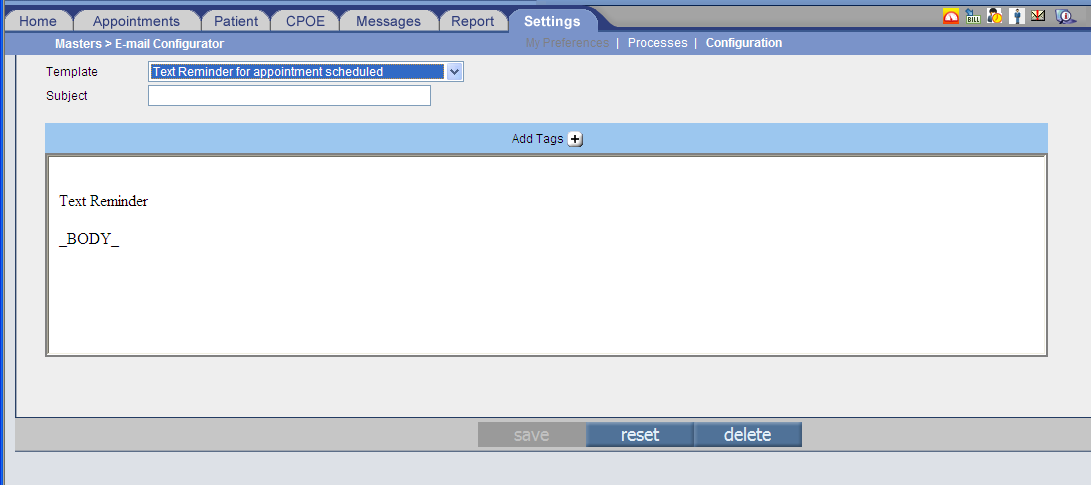
- The Add Tags [+] button invokes the Tags popup displaying pre-defined tags (15 in all) that can be utilized by Users to select from while composing the text message to be sent to Patient’s for Appointment Reminder.
- Text Reminder is a scheduled process; SMS_SCHEDULED_APPTS is the process name that has is defined from Scheduled Processes screen (GoTo tab: Settings → Configuration → column: Clinic → Scheduled Process link), Refer to the following figure 4.3-3
- The Text Reminder process is run in the morning and User (with appropriate rights) is expected to enter params value with period information. The numeric value entered decides the number of day(s) before the Scheduled appointment that the reminder has to be sent.
Figure 4.3-3 : Scheduled Process screen displayed along with the popup that takes in Period value
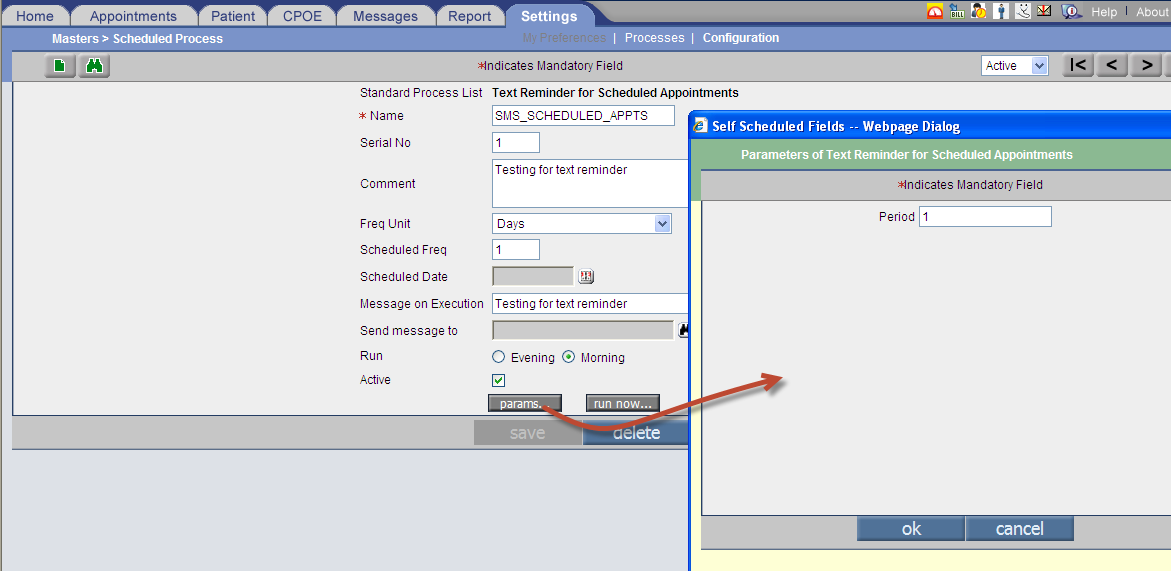
![]() Note:
Note:
- 'Text Reminder for Appointments’ is an additional service and won’t be available if a Clinic has not opted for this service.
- A maximum of 130 characters can be entered to frame a text for sending reminders. Excess characters added would be truncated and only the first 30 characters entered will be sent.
- A new scheduled process Update SMS sent status has been added that would confirm successful receipt of the message sent.
- A new tabular report, Text Reminders explicitly added to display reminder details such Name of Patient; Appointment Date; Cell Number; Reminder Date; Status; Error Message.
Navigation– : GoTo tab: Patient → Register → tab: Billing Info .
• The field, Patient Attorney has been provided on the Billing Info tab along with Attorney Search. Refer the following figure 4.4-1
Figure 4.4-1: Patient Attorney field on Billing Info tab
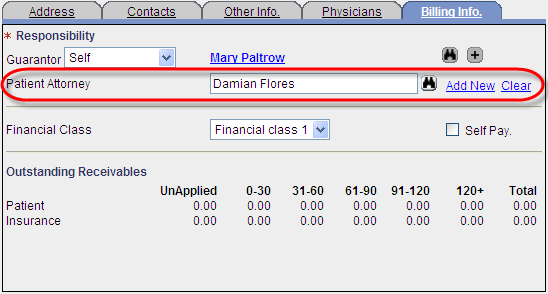
• The Attorney search is invoked from the search icon:
• The Add New link invokes Attorney popup to enter details for a new Attorney details.
• The Clear link, clears the details entered in the Patient Attorney field.
• It is now possible to automatically copy templates from previous encounter to the current encounter for same specialty ONLY.
• User can customize the autocopy feature using seven different options namely, Autocopy All; Autocopy By Specialty; Autocopy Abnormal Tests; Autocopy Abnormal Tests By Specialty; Autocopy Abnormal Tests for FS Templates; Copy Button; and None.
Workflow:
- Navigation – GoTo tab: Settings → Configuration → Specialty.
- Five new fields, such as Vital, HPI, ROS, Physical History, and Specialty have been added to the Specialty Master screen, Refer the following figure 5.1-1
Figure 5.1-1: The Master Specialty screen displaying the newly added fields, Vitals, HPI, ROS, Physical History, and Specialty
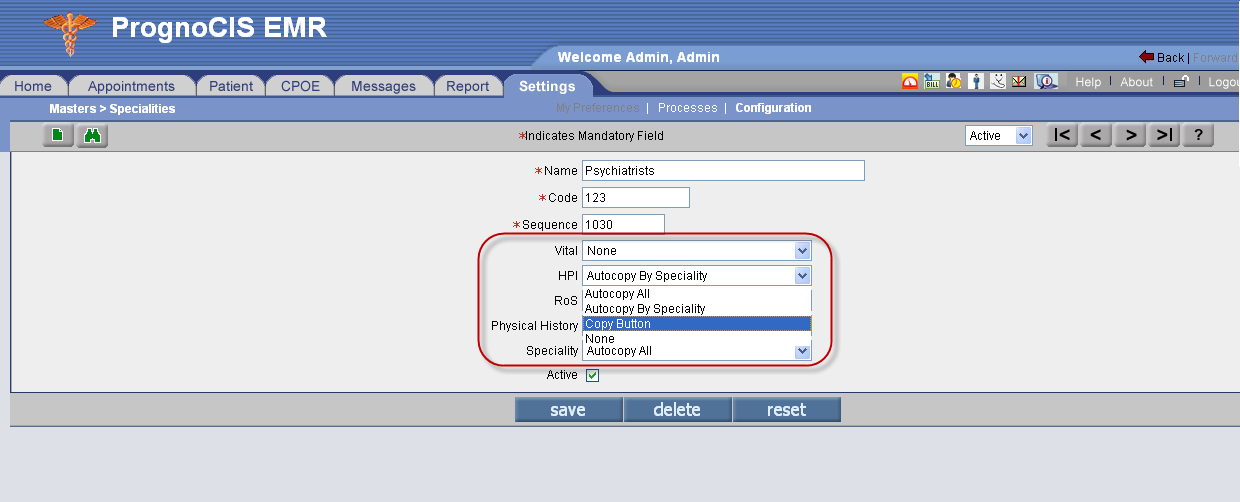
• Following are the options provided in drop-down list to copy notes:
- Based on the selected Autocopy option, all the templates are automatically copied from same specialty or from different specialty between the encounters.
- The copy button appears on respective screens, for example navigate to tab: Patient ? Encounter ? ROS , Refer the following figure 5.1-2
• Autocopy All - Automatically copies all templates from previous encounter to the current encounter irrespective of specialty.
• Autocopy by Speciality- Automatically copies all templates of previous encounter to current encounter with same Specialty.
• Copy Button -By selecting this option, the copy button is enabled on Vital/ HPI/ ROS/ Physical History/ Specialty screen.
• None- By selecting this option, the Autocopy feature is disabled.
• Autocopy Abnormal Tests- Automatically copies all templates of abnormal test results ONLY of all specialties from previous encounter to the current encounter. This option is available for Specialty field.
• Autocopy Abnormal Tests By Specialty- Automatically copies all templates of abnormal test results of same specialty. This option is available only for Specialty field.
• Autocopy Abnormal Tests For FS Templates – Automatically copies all FS (Face Sheet) templates for abnormal tests. This option is available only for Specialty field.
Figure 5.1-2: The ROS screen displaying Copy button

![]() Note:
Note:
• If a patient visits specialties A, B, C, and again B, then respective specialty’s last encounter notes are copied further.
• With this new change, existing applicable copy properties have become obsolete.
- applicable.test.copy.HP
- applicable.test.copy.PH
- applicable.test.copy.RS
- applicable.test.copy.SC
- applicable.test.copy.SH
- applicable.test.copy.VT
• Also properties specialty.copy.carryforward and specialty.copy.abnormal have become obsolete.
• A combination vaccine is a vaccine that consists of two or more separate vaccines physically combined into a single dose in order to reduce the number of shots given.
• Combo Vaccines are defined from the Vaccines Master (GoTo tab: Settings → Configuration → Vaccines).
• A newly added panel displays the Constituent Vaccine List, wherein vaccines are added to the list to prepare a Combo Vaccine. Refer to the following figure 5.2-1
Figure 5.2-1 : Panel displaying list of Constituent Vaccine
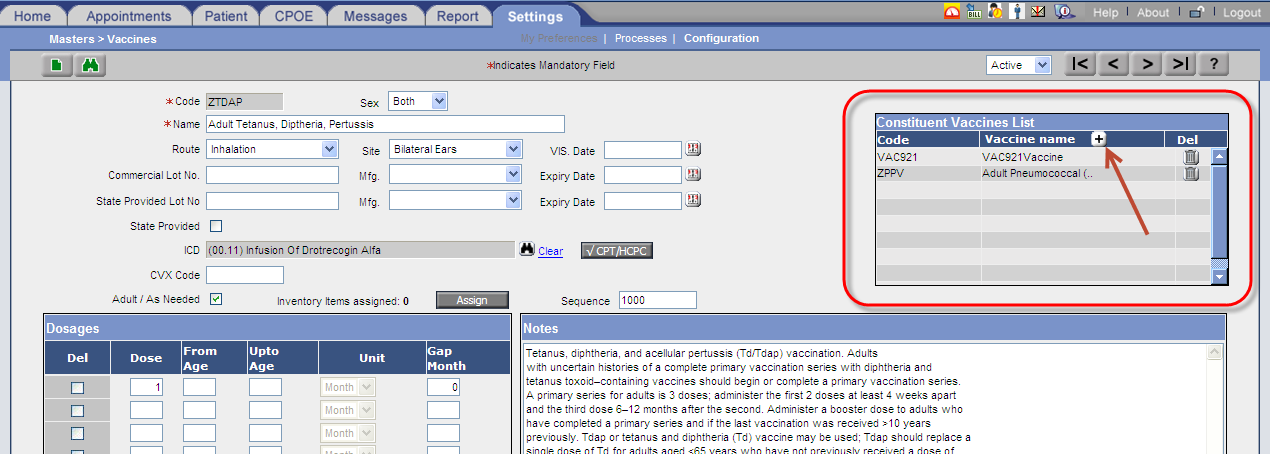
• On click on [+] button a list of active constituent vaccine(s) is displayed. Refer to the following figure 5.2-2
Figure 5.2-2 : Search popup displaying all the active constituents vaccines available
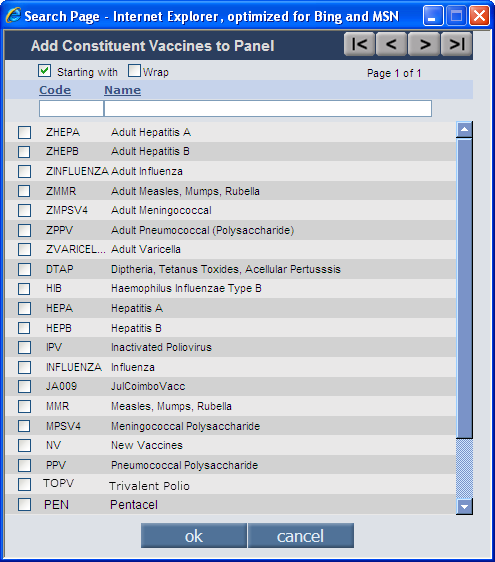
• Vaccines once added to combo vaccine are call as Constituent vaccine.
• Constituents for a Combo vaccine can be added only after a Combo Vaccine has been saved.
• Constituent vaccine is deleted from Combo vaccine via the available trash can icon: ![]()
• A Combo vaccine can be deleted only if it is NOT associated with any Encounter wherein it has been administered. And If a Combo vaccination is deleted then it gets deleted along with its associated constituents.
• An administered Combo vaccine, displays the list of its constituents on the Vaccination screen (GoTo Encounter TOC → Face sheet → Vaccination) with status as ‘Administered’. Refer to the following figure 5.2-3
Figure 5.2-3 : Combo vaccine and its constituent vaccines displayed as administered

• Details entered on the administer popup for a Combo vaccine are also applicable to its Constituent vaccine including the Lot No. (Prefixed with the vaccination code of the Combo vaccine).
• Each and every Constituents administered in number of Encounters are traced and the dose count is displayed on the Scheduled tab on the Vaccination screen.
Figure 5.2-4 : Scheduled tab displaying the Constituent vaccines along with the dose count in number of Encounters

• If a Combo vaccine has been ‘unadministered’ i.e. the status of an administered vaccine is forcibly changed to upcoming (by removing the Adm. When date value and saving the record) then the associated Constituent(s) is removed from the system while the Combo vaccine remains with its status as ‘Upcoming’.
• The display of Combo Vaccine on Records tab and on the Face sheet cell of Vaccination is property dependent. The property, facesheet.vaccination.status has a newly added value of ‘C' which if entered then displays the Combo vaccine details as mentioned earlier.
![]() Note:
Note:
- Combo vaccines cannot be added as a Constituent vaccine to any other combo vaccine. For example, if ABC and XYZ are Combo vaccines then ABC cannot be added as a Constituent vaccine to XYZ .
- Vaccines that are to be defined as a Combo vaccine cannot be added as a part of the Constituent vaccine i.e. within itself. For example, if ABC is a vaccine to be defined as a Combo vaccine then it cannot be added as a constituent to itself.
- The 'Add Constituent Vaccines to Panel' search invoked from [+] on the 'Constituent Vaccine List' panel does not list out Combo vaccines.
- A Constituent vaccine that is a part of a Combo vaccine cannot be made a Combo vaccine.
- A Constituent vaccine that is part of a Combo vaccine can also be part of another Combo vaccine. For example, if A is a Constituent vaccine, part of ABC Combo Vaccine then A can also be part of a XYZ Combo vaccine.
- Maximum of nine constituents can be added for a Combo vaccine.
• A provision to ‘refuse' a particular dose of vaccine has been provided on the Administer Vaccine popup. Refer to the following figure 5.3-1
• On selection of the option, all fields except for Comment/Reaction remains disabled.
Figure 5.3-1: Refused by Patient option available on Administer Vaccine popup
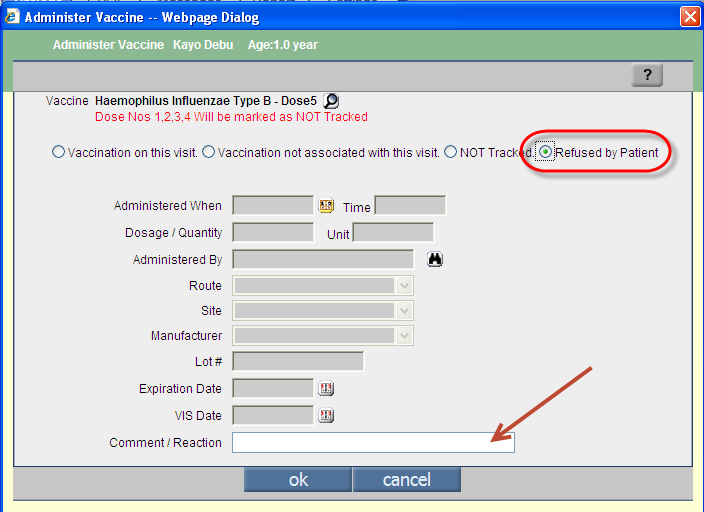
• In a scenario where a multiple dosage are attached with the vaccine and not administered, for example, vaccine Hepatitis B has 3 dosages attached and if patient refused to take 3rd dose then dose 1 and 2 will be marked as 'Not Tracked'. Refer to the following figure 5.3-2. The information of the vaccine Not being tracked and refused is displayed on the Vaccination screen as well on the Vaccination cell found on Face Sheet.
Figure 5.3-2: Vaccination cell on Face sheet displaying the vaccines marked as Refused
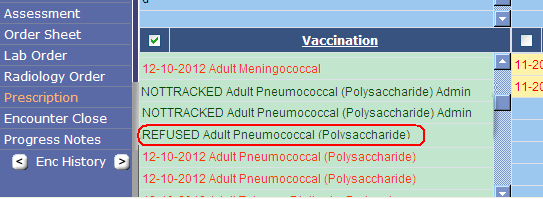
![]() Note: This ‘Not tracked’ and ‘refused’ dose is not carried forward to the Next Encounter but is displayed under 'Record' tab.
Note: This ‘Not tracked’ and ‘refused’ dose is not carried forward to the Next Encounter but is displayed under 'Record' tab.
• Phrase selection has been enhanced to display category-wise grouping, Refer to the following figure 5.4-1
• With the new Phrase search User can perform search based on the Category, phrase title and/or textual search or search based on keywords.
• The Category associated to phrase is also displayed.
• Multiple selections of phrases are allowed.
• It is now also possible to add phrases with unlimited characters.
Figure 5.4-1: Phrases Search popup displaying category-wise grouping
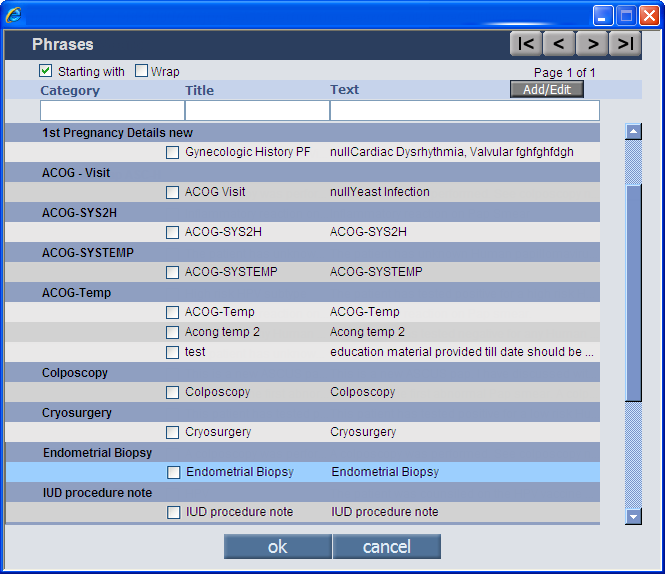
• To add a new Phrase category, click the Add/Edit button and fill in the Category detail along with Phrases text, from the popup. Refer to the following figure 5.4-2
Figure 5.4-2: Phrases Popup to add new Phrase category
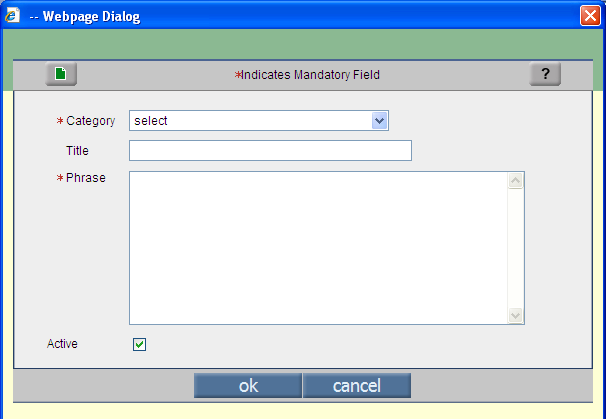
• To edit an existing phrase select the respective checkbox and then click Add/Edit button. At a time only one phrase is allowed for selection and editing.
• The Phrases Master (Go to Settings → Configuration → Phrases Types ) also displays category-wise grouping. Refer to the following figure 5.4-3
Figure 5.4-3: Phrases Search popup (Masters) displaying ‘add new’ button to add new phrases under a selected category
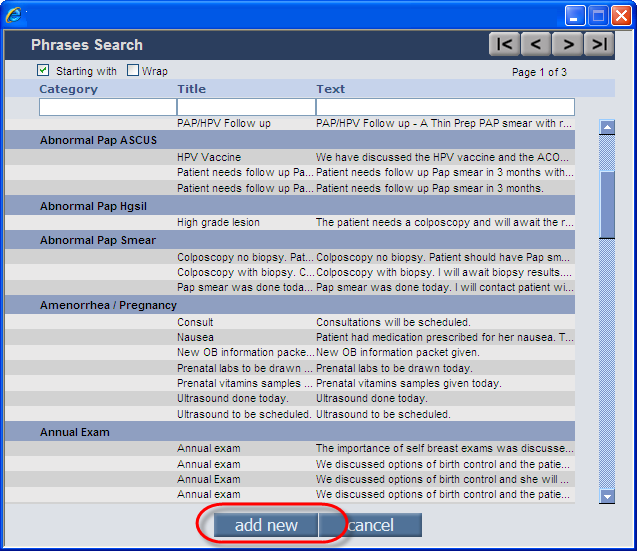
• The add new button displays the screen of the chosen Phrase Type to add new phrases under a selected category. Refer to the following figure 5.4-4
Figure 5.4-4: Links, ‘Add New' and 'Edit' available to add and edit category
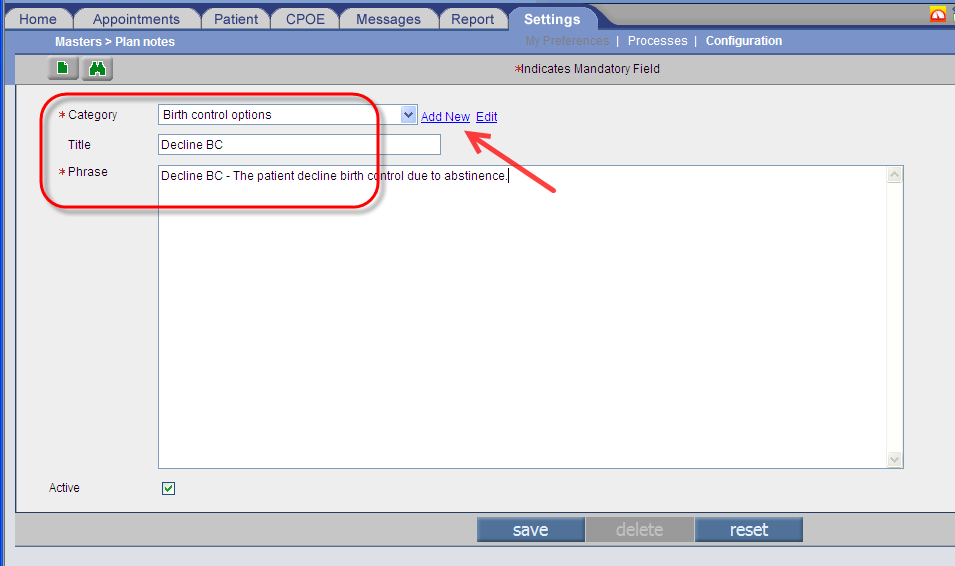
• The Add New link is provided to add a new category, it opens a popup, Refer to the following figure 5.4-5
Figure 5.4-5: Popup to add new category of Phrases
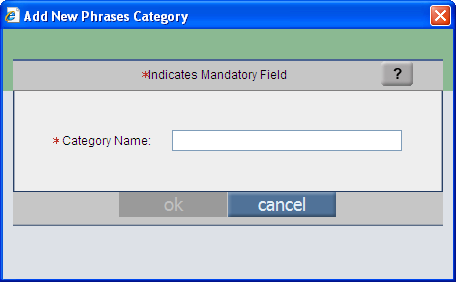
• The Edit link helps in editing the Category Name of existing categories.
Limitation: There is a limit to the extent that the tool tip can display entered text. Refer to following figure 5.4-6. The limit is however browser dependent. For example, Internet Explorer (IE) supports maximum of 512 characters whereas Chrome supports maximum of 1024.
Figure 5.4-6: Number of characters displayed in Tooltip is browser dependent
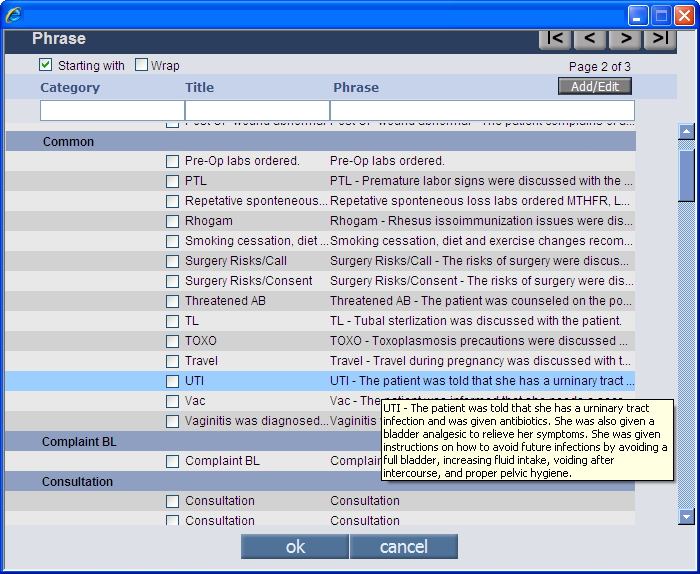
• The Procedural codes, CPT and HCPC are now displayed in a single list. Refer to following figure 5.5-1
Figure 5.5-1: Search Popup displaying a common list of CPT and HCPC codes
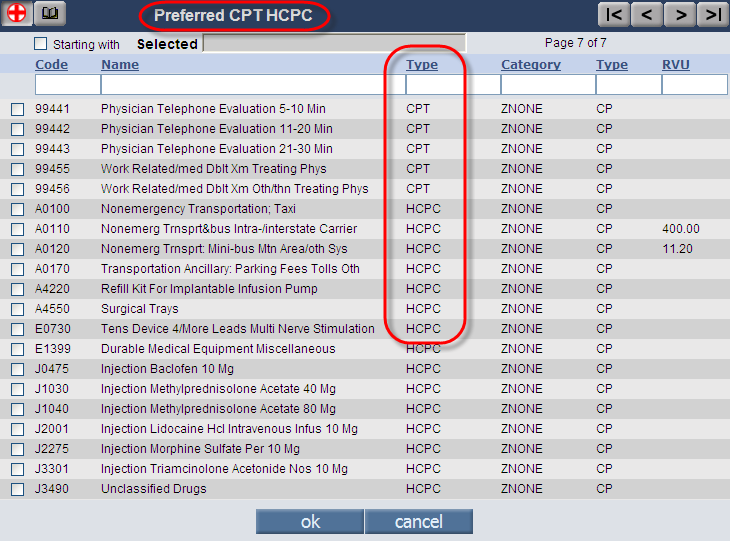
• Common CPT/HCPC buttons are also available to assign these codes .Refer to following figure 5.5-2
Figure 5.5-2: A common CPT/HCPC tab available to assign procedural codes

• A common CPT/HCPC buttons are also available to assign these codes, Refer to following figure 5.5-3
Figure 5.5-3: Specialty screen displaying Common CPT and HCPC button

• Now, along with CPT or HCPC codes, Revenue codes too are considered; revenue codes are three digit numbers used on hospital bills, indicating to the Insurance Company, either the patient’s place of treatment or the type of items received by Patient as part of his or her treatment.
• Procedural codes that are copied to the Assessment screen also copy the Revenue codes but they aren’t displayed anywhere on the Assessment screen.
• Revenue codes are assigned from CPT Master screen (GoTo tab: Settings → Configuration → column: Codes/Drugs → CPT) and HCPC Master Screen (GoTo tab: Settings → Configuration → column: Codes/Drugs → HCPC); a new field, Revenue Code along with search has been provided, Refer to following figures 5.5-4 and 5.5-5
Figure 5.5-4: Newly added Revenue Code field
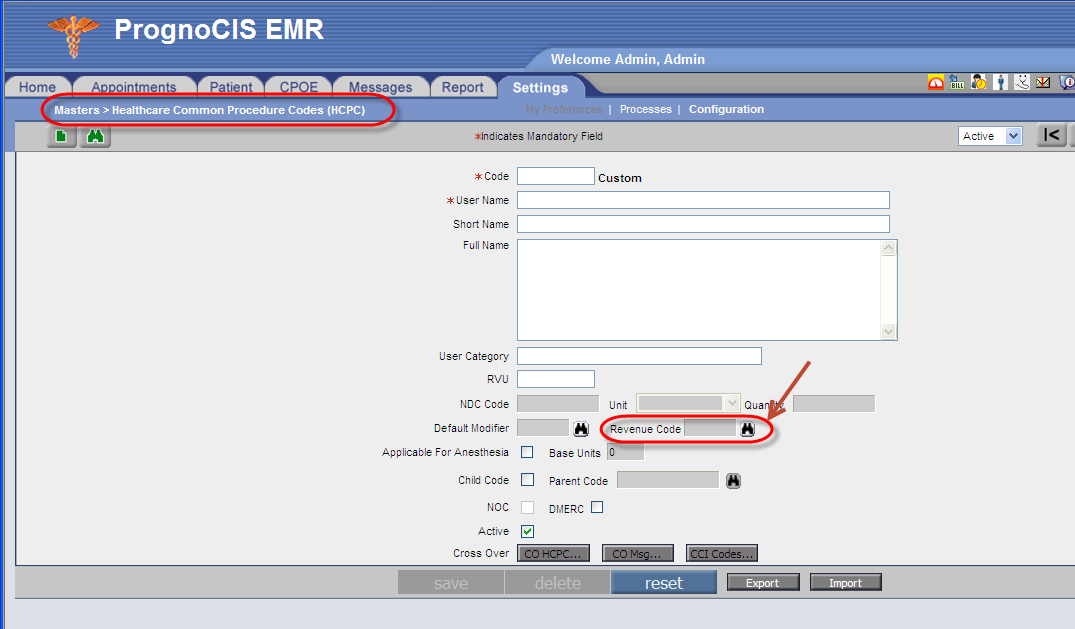
Figure 5.5-5: Revenue Code Search popup
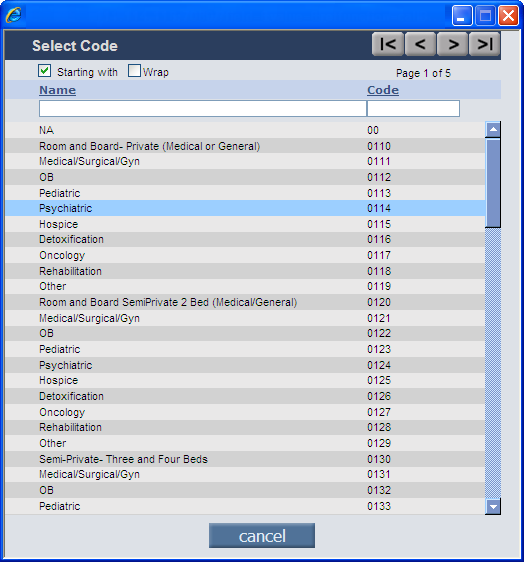
• Revenue codes found on Revenue search popup are added from the backend directly into the database.
• There are common CPT/HCPC buttons available also at the Settings end, Refer to following figure 5.5-6. A combined list can be previewed from table 5.5-1.
Figure 5.5-6: Screen displaying common CPT/HCPC buttons at the Settings end
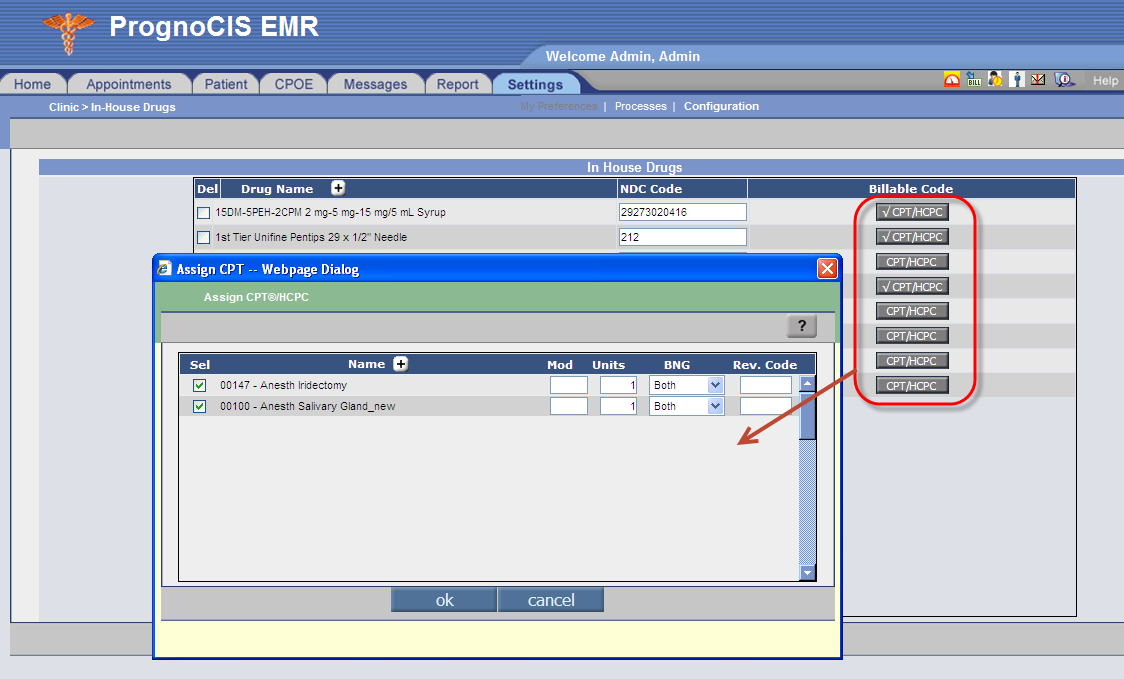
• Following is the list of screens displaying the common CPT/HCPC button from Settings end:
Table 5.5-1: List of screens displaying the common CPT/HCPC from Settings end
| Nos. | Path | |
|---|---|---|
1. |
Vaccines |
Tab: Settings → Configuration → column: Codes/Drugs → Vaccine |
2. |
Items |
Tab: Settings → Configuration → column: Vendors → Vaccine |
3. |
Test Master – Lab and Radiology |
Tab: Settings → Configuration → column: Lab → Tests And Tab: Settings → Configuration → column: Clinic → Radiology |
4. |
In-House Drug |
Tab: Settings → Configuration → column: Clinic → In-House Drug |
5. |
Specialty |
Tab: Settings → Configuration → Tests → Specialty |
• Following is the list of newly added tags that are a combination CPT and HCPC with respect to Revenue code. Refer to table 5.5-2
Table 5.5-2: List of tags that are a combination CPT and HCPC
| Nos. | Tags |
|---|---|
1. |
ENC_ASS_CPTHCPC__LINE_CODE |
2. |
ENC_ASS_CPTHCPC__LINE_CODE_LNAME |
3. |
ENC_ASS_CPTHCPC__LINE_CODE_BNAME |
4. |
ENC_ASS_CPTHCPC__LINE_CODE_SNAME |
5. |
ENC_ASS_CPTHCPC__LINE_BNAME |
6. |
ENC_ASS_CPTHCPC__LINE_SNAME |
7. |
ENC_ASS_CPTHCPC__LINE_LNAME |
8. |
ENC_ASS_CPTHCPC__STR_CODE |
9. |
ENC_ASS_CPTHCPC__STR_CODE_LNAME |
10. |
ENC_ASS_CPTHCPC__STR_CODE_BNAME |
11. |
ENC_ASS_CPTHCPC__STR_CODE_SNAME |
12. |
ENC_ASS_CPTHCPC__STR_ICD |
13. |
ENC_ASS_CPTHCPC__STR_BNAME |
14. |
ENC_ASS_CPTHCPC__STR_SNAME |
15. |
ENC_ASS_CPTHCPC__STR_LNAME |
16. |
ENC_ASS_CPTNONENMHCPC__STR |
17. |
ENC_ASS_CPTHCPC__TBL_CODE |
18. |
ENC_ASS_CPTHCPC__TBL_CODE_LNAME |
19. |
ENC_ASS_CPTHCPC__TBL_CODE_BNAME |
20. |
ENC_ASS_CPTHCPC__TBL_CODE_SNAME |
21. |
ENC_ASS_CPTHCPC__TBL_BNAME |
22. |
ENC_ASS_CPTHCPC__TBL_SNAME |
23. |
ENC_ASS_CPTHCPC__TBL_LNAME |
24. |
ENC_ASS_CPTNONENMHCPC__TBL |
25. |
ENC_ASS_CPTHCPC__STR_CM |
26. |
ENC_ASS_CPTHCPC__TBL_CM |
27. |
ENC_ASS_CPTHCPC__TBL$ |
28. |
ENC_ASS_CPTHCPC__STR$ |
29. |
ENC_ASS_CPTHCPC__LINE$ |
• With the implementation of Revenue Codes, following table lists out properties that have now become obsolete from PrognoCIS: Refer to table 5.5-3
Table 5.5-3: List of properties that have become obsolete
| Nos. | Properties |
|---|---|
1. |
assessment.hcpc.newrows |
2. |
assessment.duplicate.hcpc |
3. |
assessment.addhcpc.fromspl |
4. |
hcpc.max_rows |
5. |
assessment.addhcpc.frominhousedrug |
6. |
export.charge.hcpc |
7. |
export.charge.hcpcicd.rule |
8. |
assessment.hcpc.editunits |
9. |
assessment.hcpc.useonly.pref |
10. |
assessment.addhcpc.fromspltest |
11. |
assessment.addhcpc.fromvac |
12. |
assessment.hcpc.copy |
13. |
assessment.addhcpc.fromlab |
14. |
assessment.addhcpc.fromlabpanel |
15. |
assessment.addhcpc.fromrad |
16. |
assessment.addhcpc.fromradpanel |
17. |
assessment.addhcpc.from.htest4types |
18. |
assessment.addhcpc.fromspltestset |
19. |
rx.billable.unit.factor4hcpc |
20. |
assessment.addhcpc.fromsalesitems |
• It is now possible to attach as well as play a *.wav file in PrognoCIS™ on the condition that property value, ‘wav' is added to the existing property, prognocis.attach.filetypes
• The *.wav file is attached from tab: Message → tab: Attach and is played from Patient Encounter → Document List.
• The functionality is applicable only for attachment of type ‘Encounter' and ‘Other'. Refer to the following figure 5.6-1
Figure 5.6-1: Attaching image in *.wav format
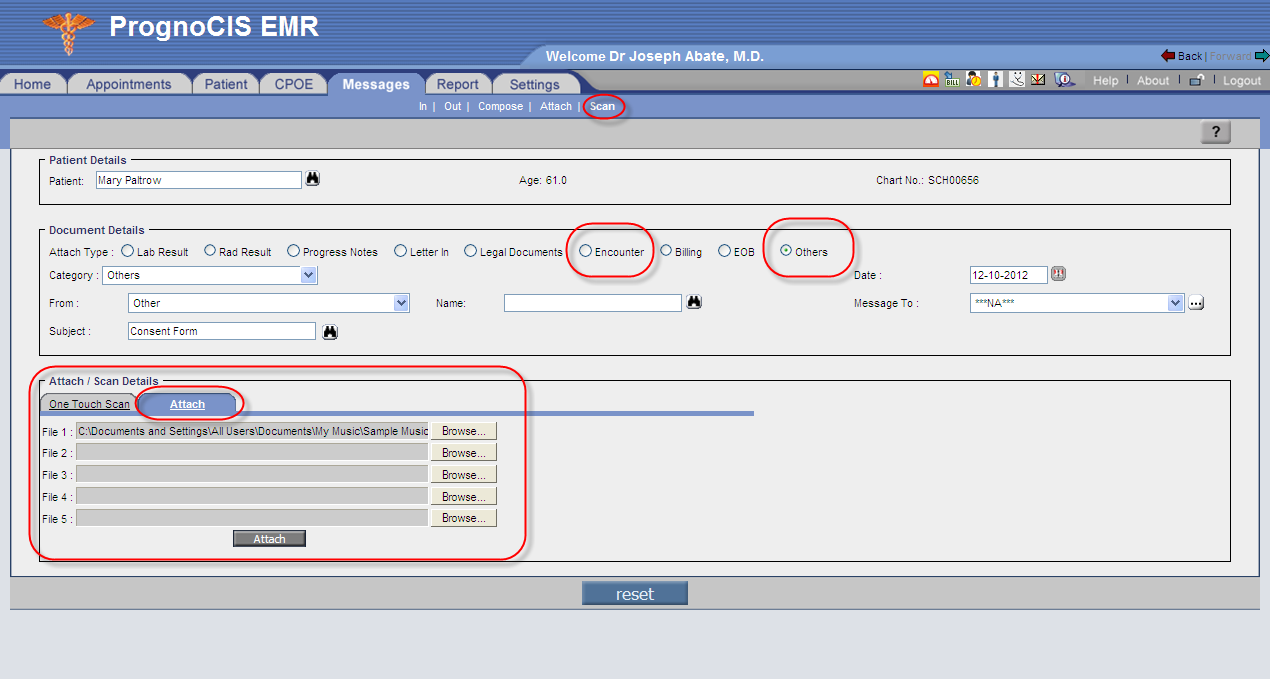
• The attached *.wav file is played from patient's Document List. Refer to the following figure 5.6-2
Figure 5.6-2: Playing *.wav file from patient's Document List
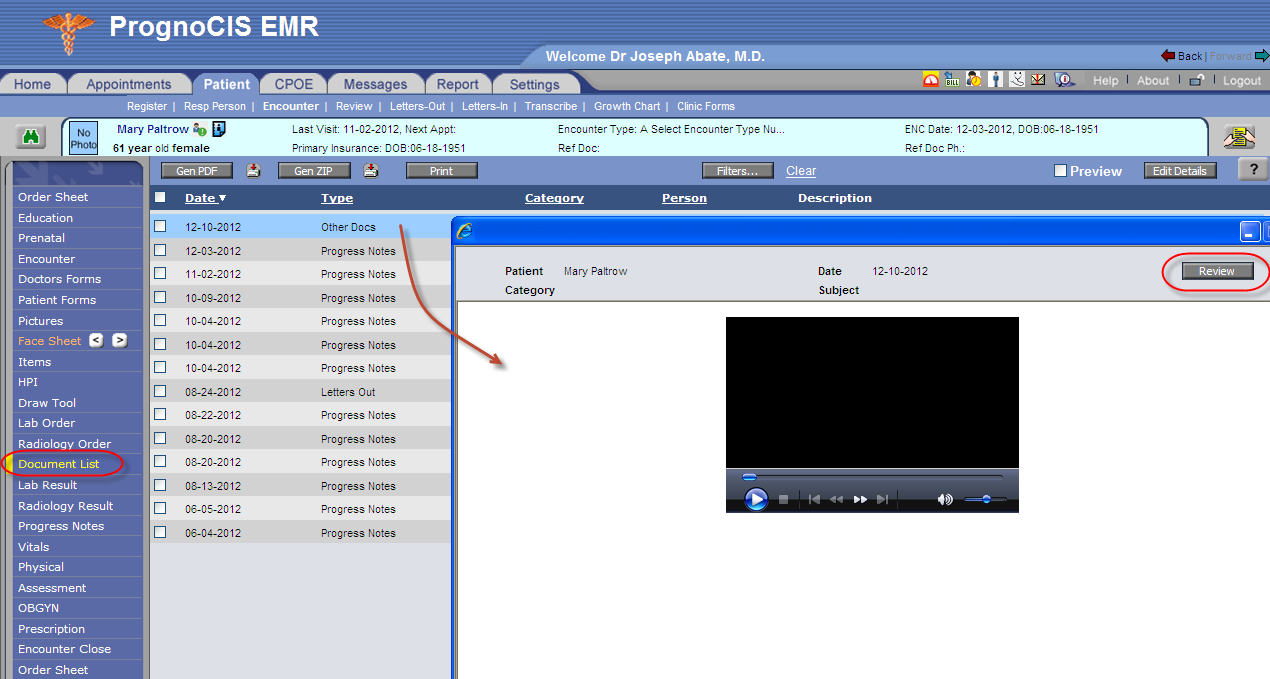
• Review comments are added from the Review button available on the top right hand corner. On click the Review popup is invoked. Refer to the following figure 5.6-3
Figure 5.6-3: Review popup to add review comments
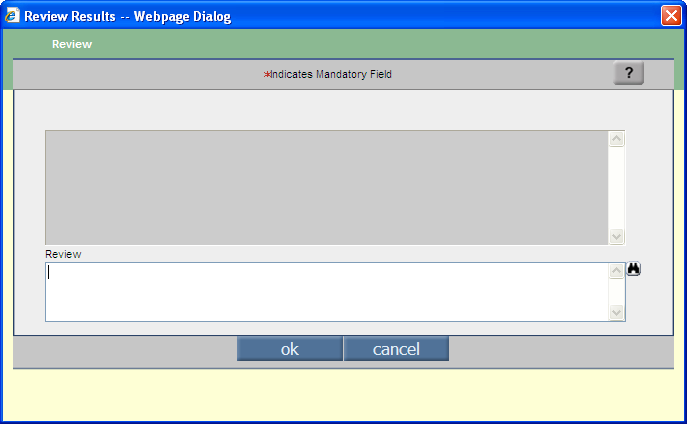
![]() Note:
Note:
- It is important to ensure that the scan.onetouch.serverpath property has been set to a valid path. This would allow files to be saved in the location defined in the property.
- A *.wav file attached cannot be displayed on Attach popup invoked from Attach button on Letter Out screen.
Navigation: GoTo Patient Encounter → CM screen → Click the History button, Refer to the following figure 5.7-1
Figure 5.7-1: Current Medication History
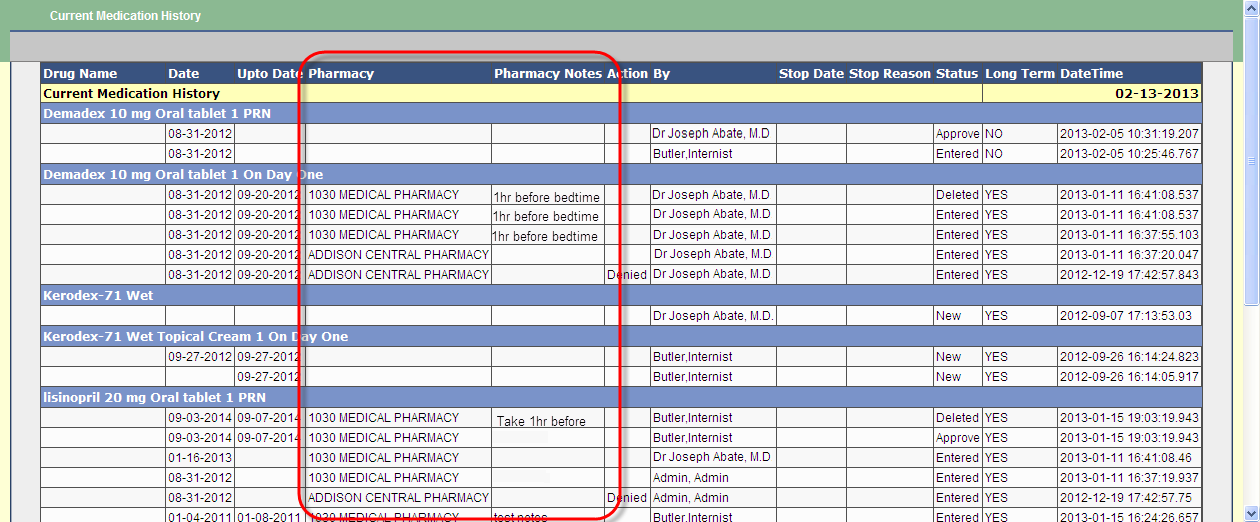
• A new column, Pharmacy has been added on the Current Medication History popup that displays the Pharmacy information for each of the drug prescribed.
• Comments field has been renamed to Pharmacy Notes.
All the Remarks and the Notes fields found on Lab Results and Radiology Results have been enhanced to accommodate unlimited character entry.
• Vitals, HPI, Specialty, ROS, Physical and Social History now support a new result type, ‘Image’. Refer to the following figure 5.9-1
• It is possible now to attach image files having extensions such as png, jpg, jpeg, gif, and bmp to a test.
• Result type, Image is defined from any GoTo tab: Settings → Configuration → Test → Result type →Change the value to ‘image’
Figure 5.9-1: Result Type drop-down menu displaying 'Image' option
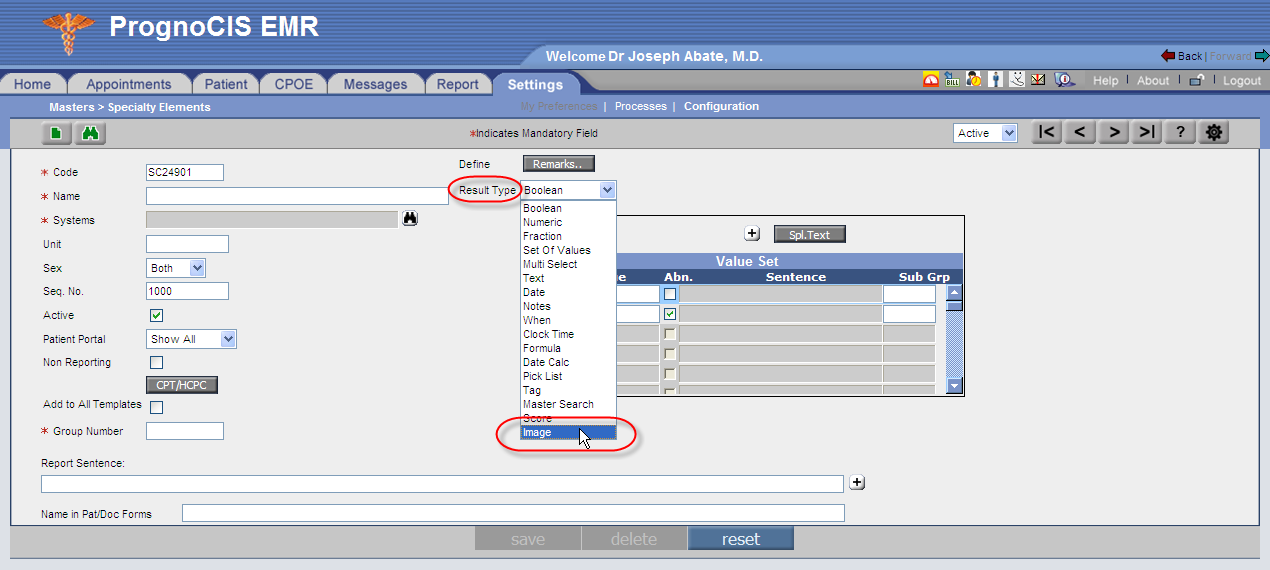
• Once defined, Attach and View buttons are displayed when User selects the Result type as ‘Image'. Refer to the following figure 5.9-2
Figure 5.9-2: Screen displaying attach and View buttons

• Workflow – from Test Exec elements such as Vitals, HPI, Specialty, ROS, Physical and Social History
Step I: User clicks on the attach icon:
Refer to figure, browses for image file from the popup invoked refer to the following figure 5.9-3, selects the image and then clicks the zoom button to view the image file selected, the image is displayed in the display area.
Figure 5.9-3: Popup to attach an image file
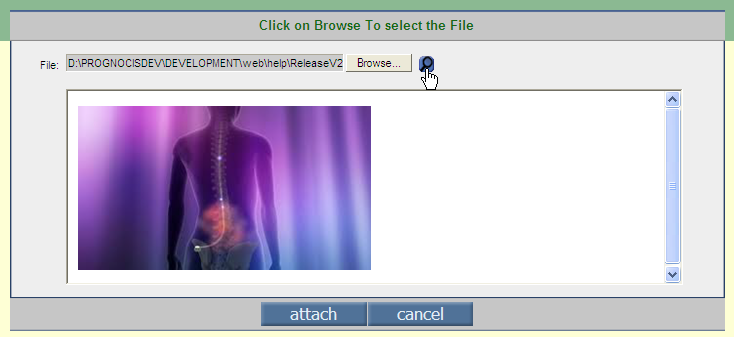
Step II: Once the attachment is confirmed then user clicks the attach button Refer to the following figure 5.9-3 and the image is attached to the selected element which is viewed from the zoom button found next to attach button.
• The feature is property dependent. The property, test.resulttype should include value, ‘G’ to display in the Result Type drop-down menu found on the Elements popup. Refer to the following figure 5.9-1
![]() Note:
Note:
- PNG, JPEG, GIF, and BMP are the type of image files that can be attached.
- The maximum size for attaching the image file is 4 MB.
• A total of eight new charts have been included in PrognoCIS™, specifically for patients with Down syndrome; four are specific to boys and the other four are specific to girls.
• These new charts are available in the Graphs drop down menu on the Growth Chart screen (GoTo tab: Patient → Growth Chart )
• Following charts have been added for boys, Refer to the following figure 5.10-1
i. Down Syndrome – Height for Boys age 2-18 Yrs.
ii. Down Syndrome – Weight for Boys age 0-3 Yrs.
iii. Down Syndrome – Weight for Boys 2-18 Yrs.
iv. Down Syndrome – Length for Boys age 0-3 Yrs.
• Following charts have been added for Girls, Refer to the following figure 5.10-1 :
i. Down Syndrome – Height for Girls age 2-18 Yrs.
ii. Down Syndrome – Weight for Girls age 0-3 Yrs.
iii. Down Syndrome – Weight for Girls 2-18 Yrs.
iv. Down Syndrome – Length for Girls age 0-3 Yrs.
• The growth line color representation is black . Refer to following figures 5.10-1
Figure 5.10-1: Chart displaying growth line for girls with Down Syndrome (2-18yrs)
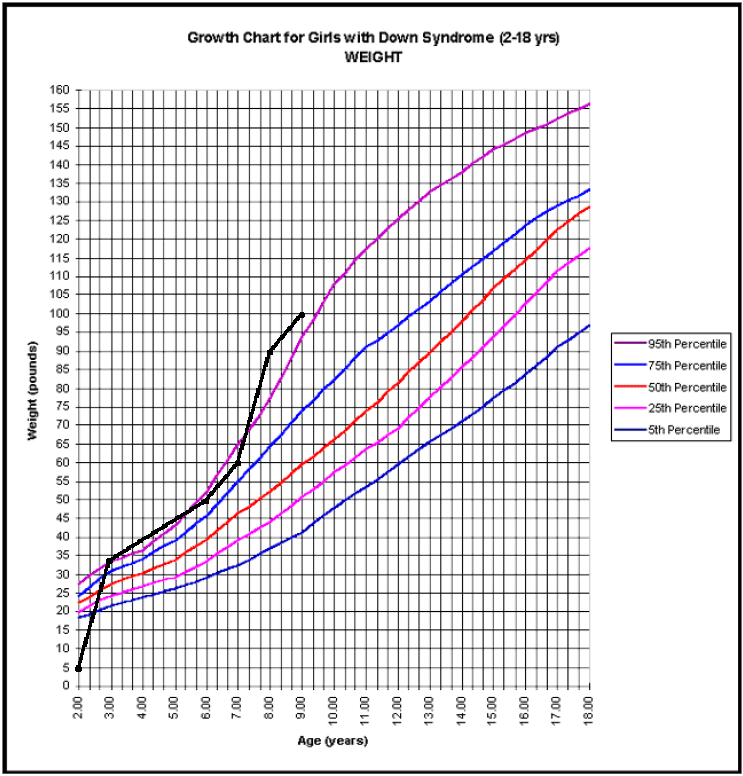
• The background colors of charts are common for both, boys and girls.
A new option, Hide Line has been added on Growth Charts to avail Users of the option to view growth of the patient in points only by hiding the default line drawn. Refer to the following figure 5.11-1
Figure 5.11-1: Growth line hidden with only the points being displayed
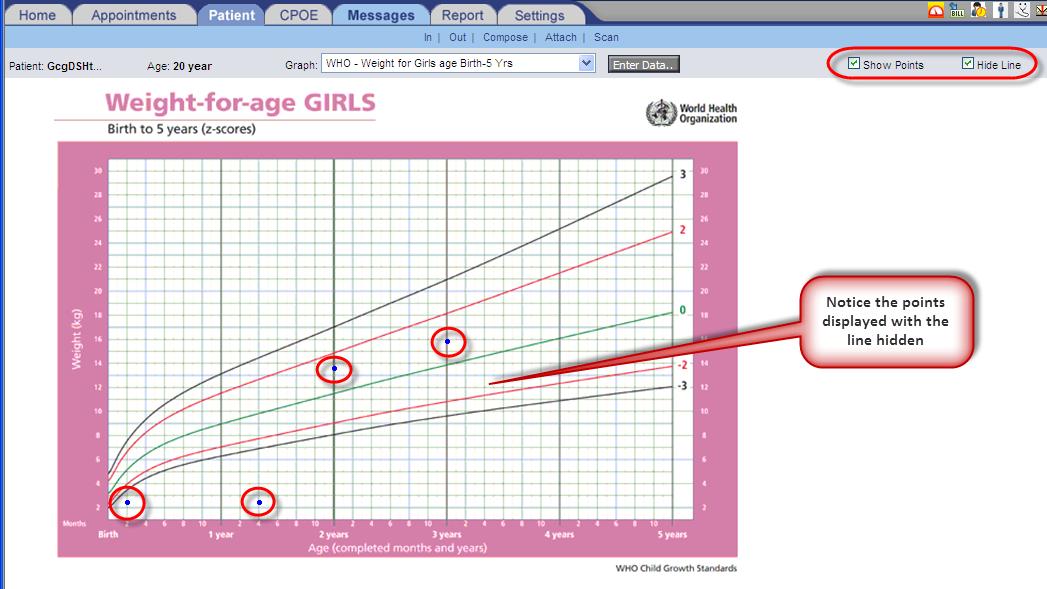
![]() Note: It is required that users have the option, Show Points selected. Refer to the following figure 5.11-1
Note: It is required that users have the option, Show Points selected. Refer to the following figure 5.11-1
• Draw Tool is now compatible with browsers such as IE9, Chrome, Safari (MAC and iPAD).
• There is a change in the look and feel of Draw Tool UI (User Interface) which is noticed for browsers IE9 and above or Chrome or Safari in MAC and iPAD, Refer to the following figure 5.12-1
• For Users using IE browsers lower than IE9, the existing Draw Tool is available.
• If a User accesses Draw Tool in IE9 with the ‘Compatibility View’ settings checked then the existing Draw Tool is available.
Figure 5.12-1: Changed Draw Tool UI
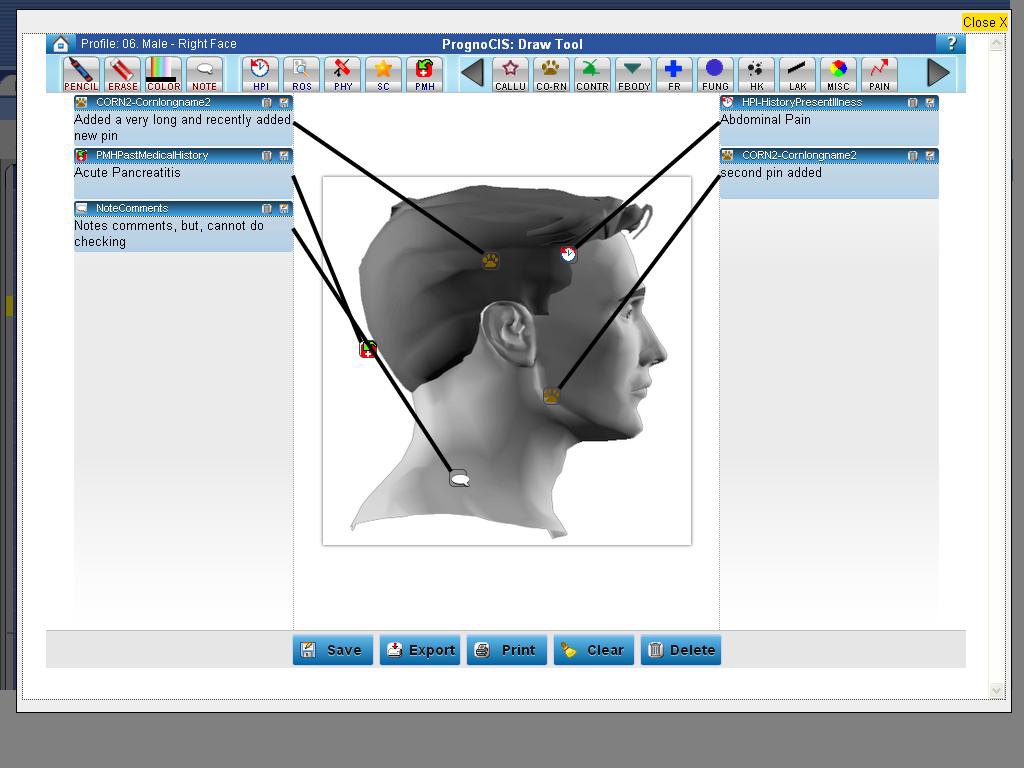
• A UI (User Interface) has been provided for a User with administrative rights (specifically an Administrator or PrognoCIS Implementation Support Group) to attach image directly to the template folder of the DrawTool in data files. The image is used as a template image for DrawTool. It is possible to ‘Preview’, ‘Download’ and ‘Delete’ the image attached. , Refer to the following figure 5.12-2
Figure 5.12-2: UI to attach Draw Tool image directly to template folder, the UI is NOT available for Clinic Users

![]() Note:
Note:
- There is a limitation to be considered, once the diagrams are opened and saved in IE9 and above versions/ Chrome/ Safari browsers, then if the diagram is reopened in a lower (browser) version then system displays an alert message and will not open the diagram.
- File name entered shouldn't be other than alphanumeric.
A new thin scroll bar (in gray) has been provided to navigate up and down the TOC menu items and the earlier up arrow and down arrow has been done with. Refer to the following figure 5.13-1
Figure 5.13-1: Screen displaying vertical scroll bar for navigation of TOC menu
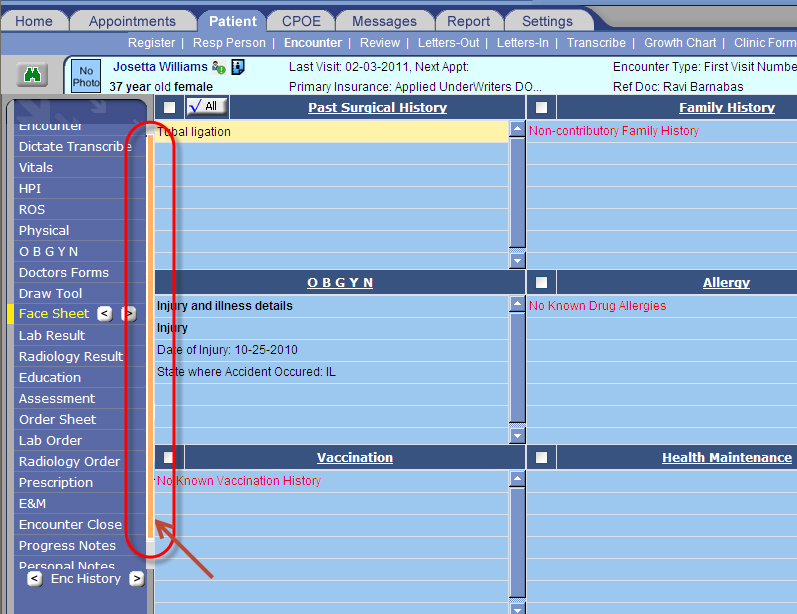
• Unlimited character entries to Notes fields have been made possible to the following screens:
i. TOC → Vitals → Notes
ii. TOC → Physical →Notes
iii. TOC → Specialty →Notes
iv. TOC → HPI → Notes
v. TOC → ROS → Notes
vi. TOC → Assessment → Notes
• The Notes fields found on Doctor Form and Patient Form has also been enhanced to accommodate unlimited character entry.
• It is now possible to delete Encounter consisting data. An alert prompt is displayed to User, when User deletes an open Encounter from the Encounter Close screen. Refer to the following figure 5.15-1
Figure 5.15-1: Alert prompt displaying pending available data in Encounter
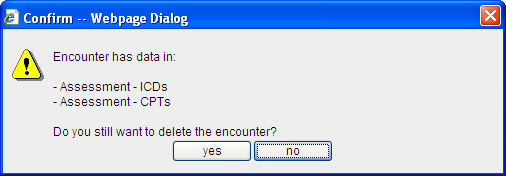
• An Encounter cannot be deleted only under following conditions:
- A Claim, associated to the Encounter has been sent i.e. billed
- A Claim, associated to the Encounter has value assigned in its ‘assigned to' field
- Letter has associated Claim attached.
The Preferred Pharmacy popup found on Prescription screen, now has the following enhancements done: Refer to figure 5.16-1
• Preferred Pharmacy is now called, ‘Patient Pharmacy';
• The icons representing Clinic Pharmacy - ![]() and Patient Pharmacy -
and Patient Pharmacy - ![]() have been changed in the Pharmacy popup. Refer to the following figure 5.16-1
have been changed in the Pharmacy popup. Refer to the following figure 5.16-1
Figure 5.16-1: Patient Pharmacy search popup displaying the new icons
![]()
![]() Note: If a User adds a Clinic pharmacy or a pharmacy that is not in patient's preferred list then added on to the list and is also displayed on the Patient Pharmacy popup.
Note: If a User adds a Clinic pharmacy or a pharmacy that is not in patient's preferred list then added on to the list and is also displayed on the Patient Pharmacy popup.
Navigation: GoTo patient Encounter → TOC → Assessment screen
User is appropriately prompted with an alert whenever an ICD code starting with ‘E’ (Procedural ICD) is attempted to be marked as the primary ICD. Refer to the following figure 5.17-1
Figure 5.17-1: Prompt displayed to alert User that E codes ICD cannot be marked as ‘Primary’
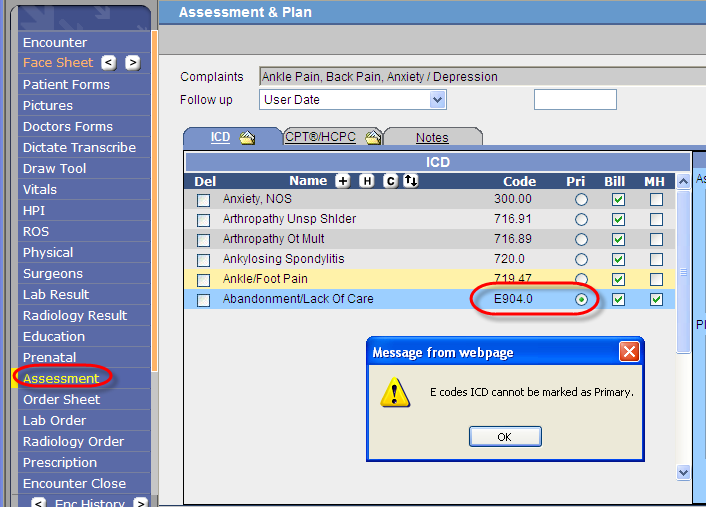
![]() Note: Similar prompt is also displayed on Encounter Close screen
Note: Similar prompt is also displayed on Encounter Close screen
User accessing a patient's Claim record from the billing module is promptly informed of changes being done to the assessment code(s) in EMR affecting the same Claim. A prompt is displayed alerting the User of change being done in EMR.
Navigation: GoTo patient Encounter → TOC → Education
The 'Last Given date' appearing on the Education screen for Brochure is now explicitly the Encounter date even if the details are updated on a later date.
Navigation: GoTo patient Encounter → TOC → Face Sheet
The functionality of keeping the current row (of record) that User is working on specifically highlighted is applied to all of screens on Face Sheet.
Navigation: GoTo Message→ Attach → Date field
The date field has been enhanced to accommodate attachments’ dates with more flexibility on date selection. Attachments dating back up to 150 years can be easily attached.
Navigation: GoTo Patient → Encounter → TOC → Order Sheet
The odersheet are now made available for Clinical Staff to add Tests .
Navigation: GoTo Patient → Encounter → TOC → Assessment
• Details added via Rx and Procedure button are displayed or appended to the Assessment Plan; the functionality is property based, depends on assessment.add.lrc2plan property.
• Multiple ICDs can be added to the Rx through the Assessment screen and on save of Prescription these ICDs are added to the respective Assessment Plan.
• Workflow –
I. On Assessment screen for Procedure button–
i. User selects a particular ICD
ii. Clicks on the Procedure button to invoke Add Procedures popup
iii. Selects single or multiple Procedures.
iv. Clicks on ok
v. The Procedural details are added or appended to the selected ICDs Assessment Plan. Refer to the following figure 5.23-1
Figure: 5.23-1: Selected Procedures added to the selected ICD's Assessment Plan
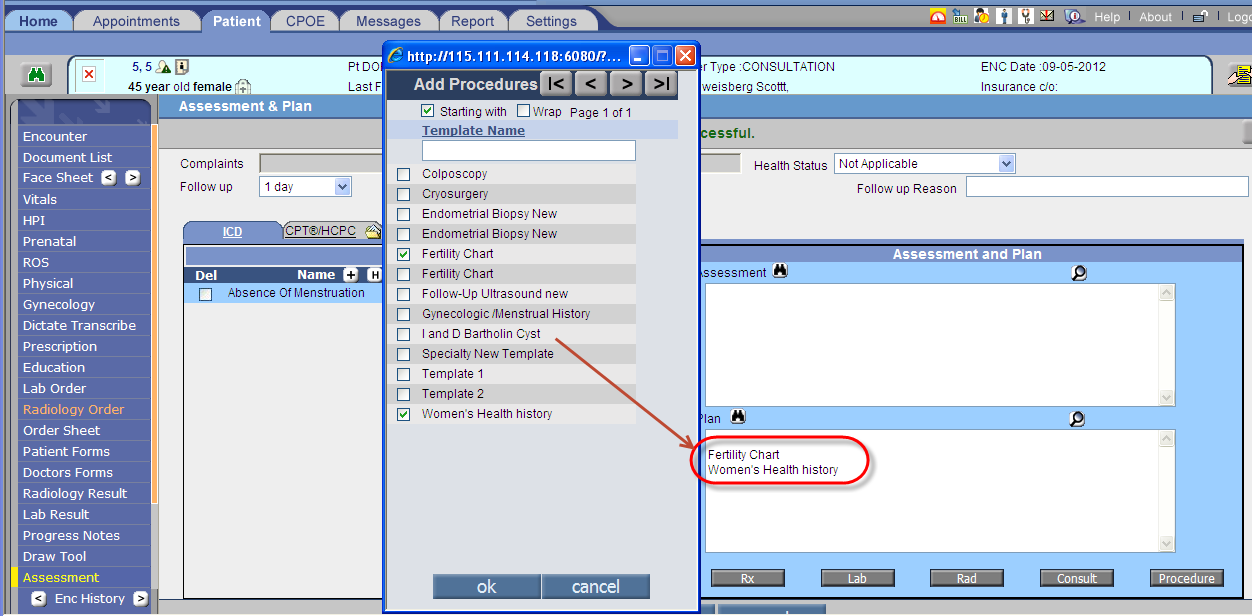
II. On Assessment screen for Rx button–
i. User adds single or multiple ICDs
ii. Clicks on the Rx button to invoke the Prescription popup, the Diagnosis field's value is SET with selected ICD and a blank row is inserted on the Prescription popup for the display of drug to be added. Refer to the following figure 5.23-2
Figure: 5.23-2: The selected ICD in Assessment screen being displayed on the Prescription screen
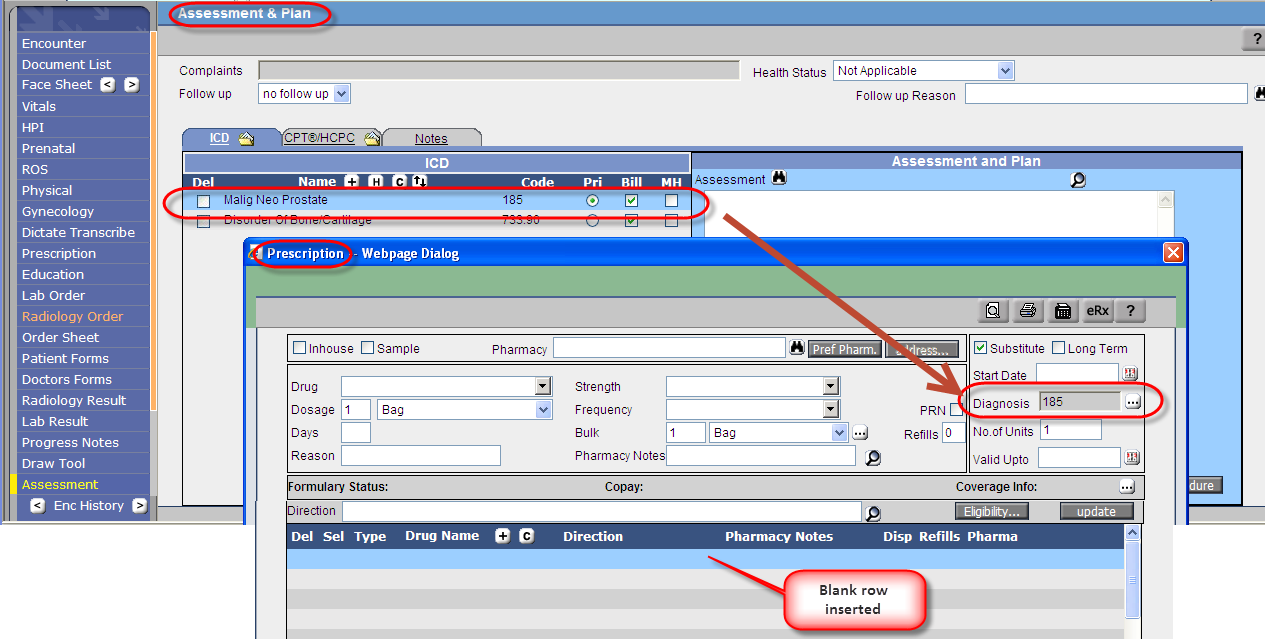
iii. On save of the Prescription, the details are automatically appended to the respective Assessment Plan.
![]() Note:
Note:
• Assessment Plan is a free text entry field.
• Deleted drug on the Prescription screen will NOT remove the drug entry from the Plan of Assessment screen.
• Deleted ICD from the Assessment screen will NOT remove the drug's associated ICD on Prescription screen.
Navigation: GoTo Patient → Encounter → TOC → Radiology Result screen → Results Tab → Attach Image icon ![]()
Users can now attach radiology image attachments of type PDF and also preview the same.
• The Vaccines for Children (VFC) program is a federally funded program that provides vaccines at no cost to children who might not otherwise be vaccinated because of inability to pay. Children who are eligible for VFC vaccines are entitled to receive those vaccines recommended by the Advisory Committee on Immunization Practices.
• VFC reduces participant Clinic's/Provider's out of pocket costs because the vaccines for eligible patients are provided to them at no additional charge.
• PrognoCIS has provision to administer VFC vaccine for VFC eligible children by assigning VFC code for vaccines.
Following are the steps involved in assigning a VFC code for a vaccine:
1. Confirm that state.provided.vaccines property has value ‘Y' assigned – this would ensure that the option, State Provided is available in Vaccine Master (GoTo tab: Settings → Configuration → Vaccine). Refer to following figure 5.25-1 and the option, Eligible for State Vaccines is available from Patient Registration screen (GoTo tab: Patient → Register → tab: Other Info). Refer to following figure 5.25-2
Figure 5.25-1 : Vaccine Master screen
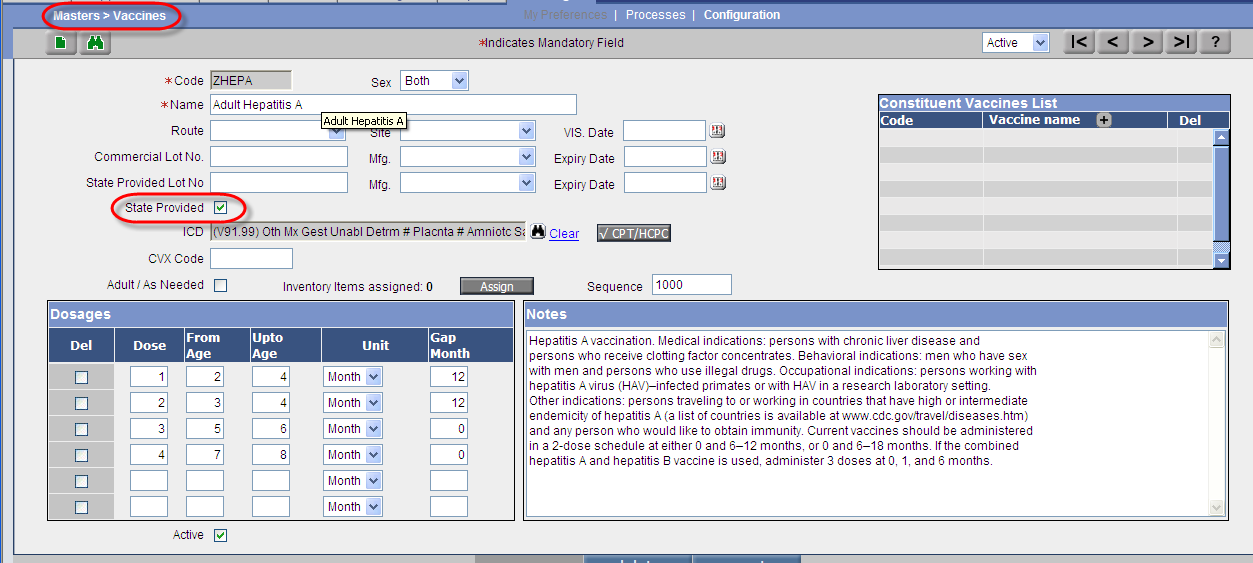
Figure 5.25-2 : Other Info tab on Patient Registration screen
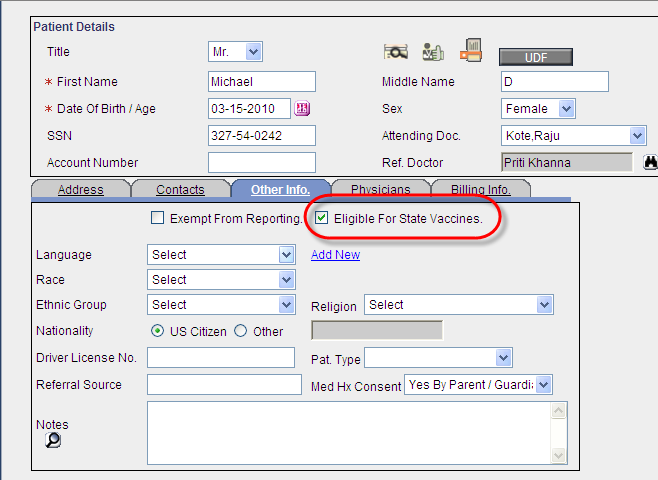
2. Select option, State Provided to specify that the selected vaccine is State provided.
3. Select the option, Eligible for State Vaccines to specify that the patient is eligible to receive State vaccines.
4. To administer the vaccine to the eligible child, GoTo patient Encounter →TOC → Face Sheet → Vaccination screen → select the vaccine → Click on administer button to invoke Administer popup. Refer to the following figure 5.25-3
Figure 5.25-3 : Administer popup on Vaccination Screen
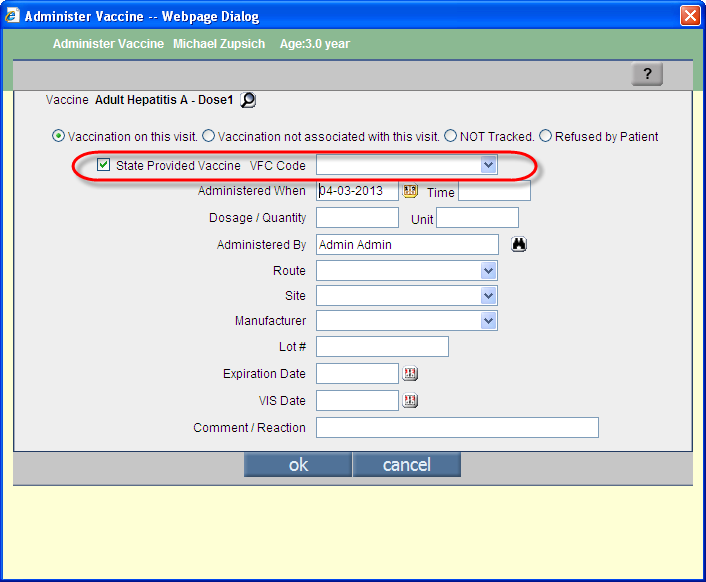
5. Select the option, State Provided Vaccine and select a VFC code from VFC Code drop-down menu from Administer Vaccine screen . Refer to the figure 5.25-3
Note:
• If the option, Eligible for State Vaccines has been selected in Patient registration screen then the options State Provided Vaccine and VFC code is available on the Administer Vaccine popup.
• Depending upon the value selected in VFC code drop-down menu the administered vaccine information is sent as State provided vaccine.
• If User does not select a VFC code then the value set in property, vaccine.vfc.defaultcode is taken by default.
• Option to deny refill drugs is now available via CPOE → Refill
• A check box, Deny is available on the Refill screen for Refill Request Encounters; the option explicitly informs Pharmacy that the drug has been denied and need not be given to the patient .
• If deny option has been selected for a particular drug then on Update, a prefix, ‘Denied' appears under Pharmacy Notes column. Refer to the following figure 6.1-1
Figure 6.1-1 : Screen displaying a prefix, ‘Denied' appears in Pharmacy Notes
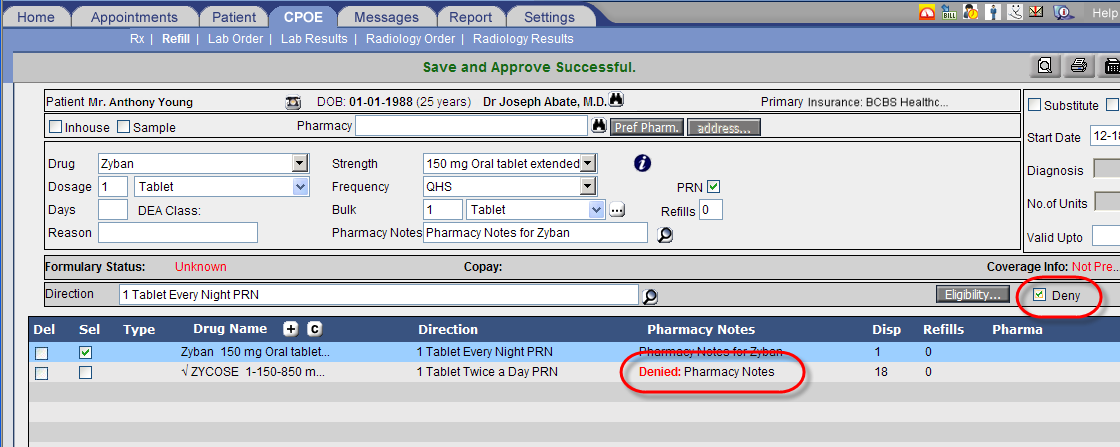
• A denied drug can be printed, faxed, but not sent via eRx.
• The existing tag, [RX_DRUG__NAME] has been modified to print denied drug(s) names with a prefix, ‘Denied'. Refer to the following figure 6.1-2
Figure 6.1-2 : Screen displaying denied drug(s) names with a prefix, ‘Denied' for printing in red
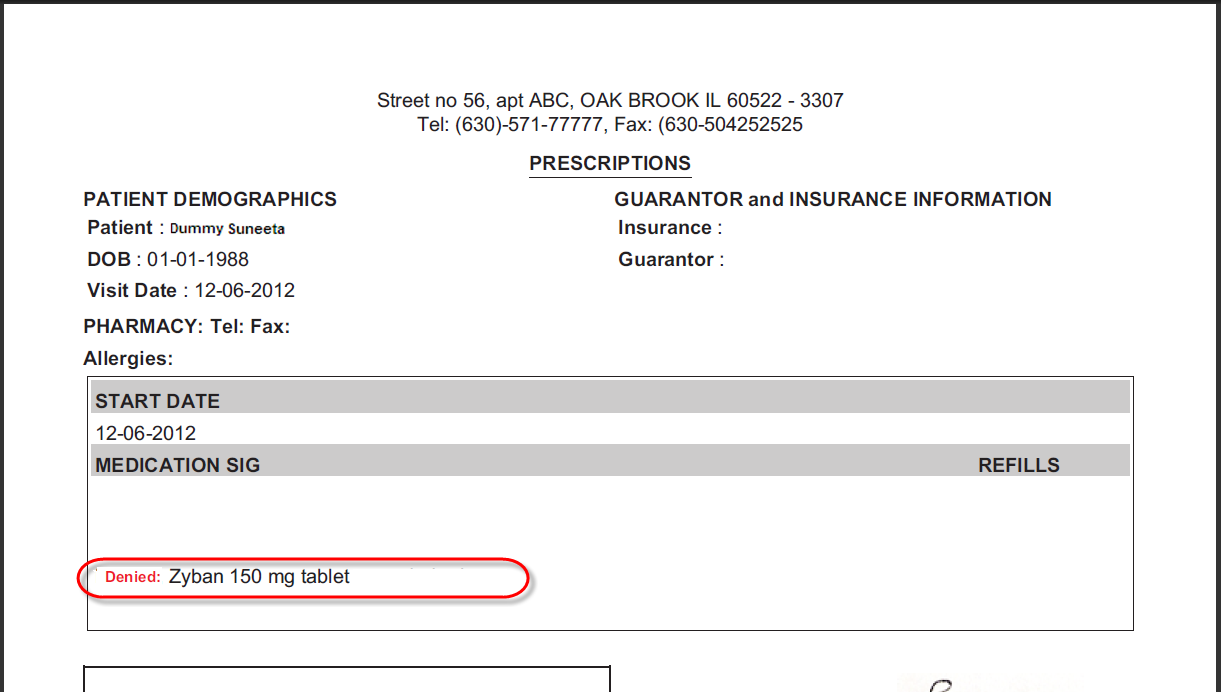
• The existing property, rx.edit.sent.drugs has been modified to include the functionality of Deny option i.e. if the property value is set as ‘Y' then the Deny option remains available even after a drug has been sent and vice-a-versa.
• Drug interaction messages are not shown for a denied drug.
![]() Note:
Note:
- Denied drugs are not displayed on Current Medication list, but are part of patient's Past Rx. For a denied drug, the action buttons (such as Continue, Edit Rx, Stop, Over, and delete) are found to be disabled; ONLY the option to Refill is allowed .
- On Start of an Encounter, the previously denied drug(s) is not available in the Current Encounter.
Provision is made in PrognoCIS™ to display patient's primary Insurance company name on Rx and Refill screens ( GoTo tab CPOE → Rx and tab CPOE →Refill screen ). Refer to the following figure 6.2-1
Figure 6.2-1 : Screen displaying patient's primary insurance company name
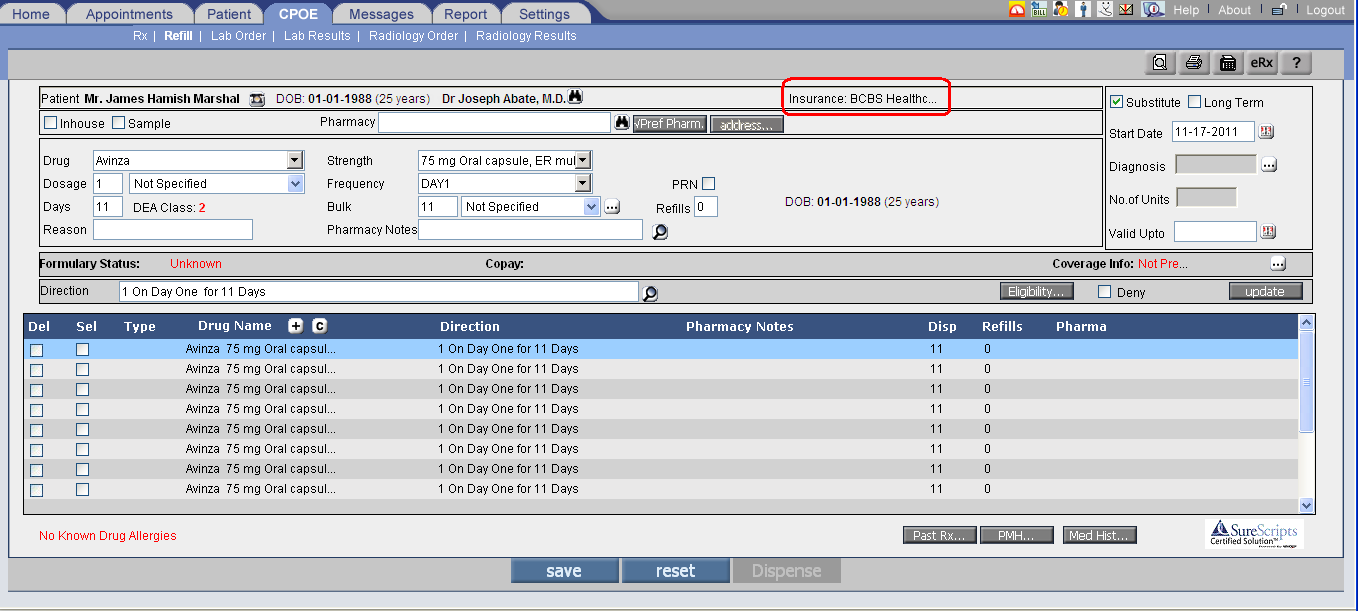
Label Printer icon is now also available to print Radiology– in extension to the already existing feature to print Lab details. Refer to the following figure 6.3-1
Figure 6.3-1: Label Printer icon on CPOE Radiology Order screen
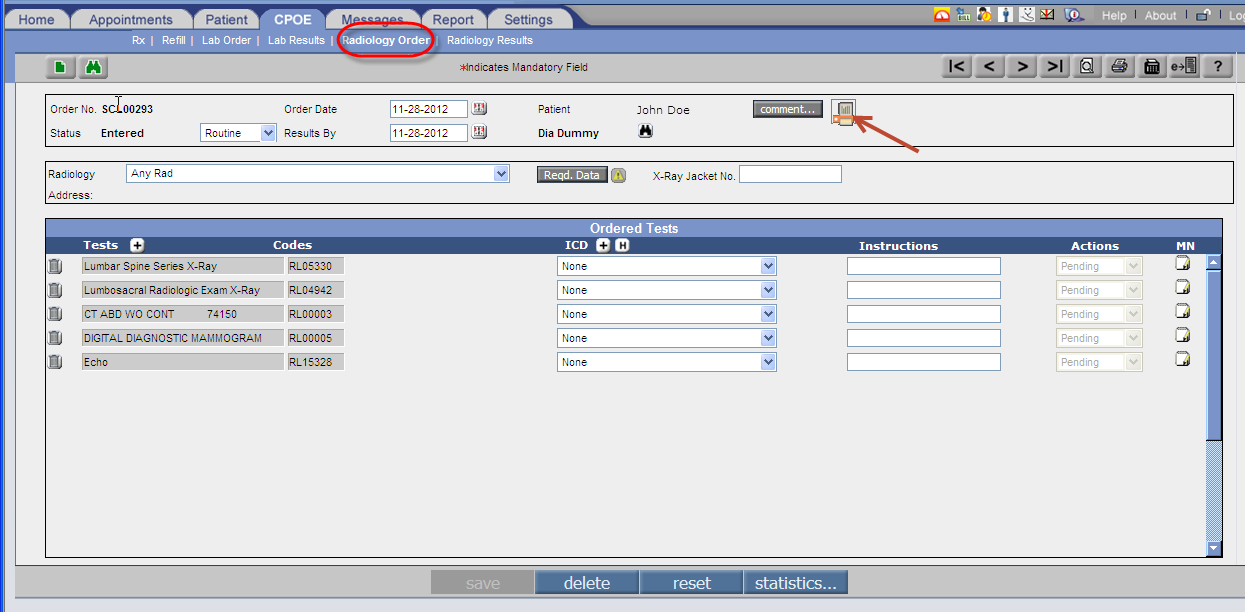
Patient Notes attached to Patient Medical Records from tab: Message → Compose when previewed and viewed from Document List will now display the time of addition as that of Clinic Location.
A new column, Comment has been additionally added to the Properties screen, allowing Users to enter additional comments with respect to the property selected. For example: Enter the reason for changes done in the property value also enter the information as the last changes where done by whom. , Refer the following figure 8.1-1
Figure 8.1-1: Newly added ‘Comments' column
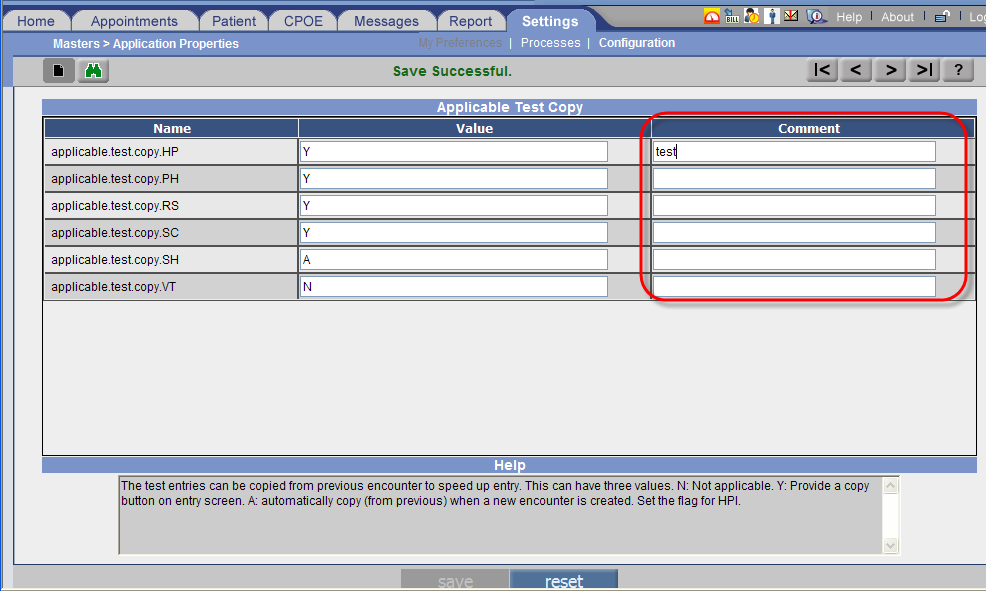
Encounter types such as ‘FS', ‘DB', and ‘XX' are system defined and User cannot create an encounter type using these codes. An error message is displayed for the User, “ This Code is already present: Record cannot be Added. ”
![]() Note:
Note:
• All the pre-existing XX type of Encounters is renamed as X1.
• When a Patient's record is merged then for the merged Patient the FS Encounter type is changed to XX and the patient record becomes inactive.
Limitation: System allows a User to reactivate the patient record via the patient registration screen (tab: Patient → Register)
• Provision to define customized templates of Label Printer is now available in PrognoCIS™.
Workflow
- Navigation – GoTo tab: Settings → Configuration → Templates → Label. Refer to the following figure 8.3-1
Figure 8.3-1 : Newly added label link displayed
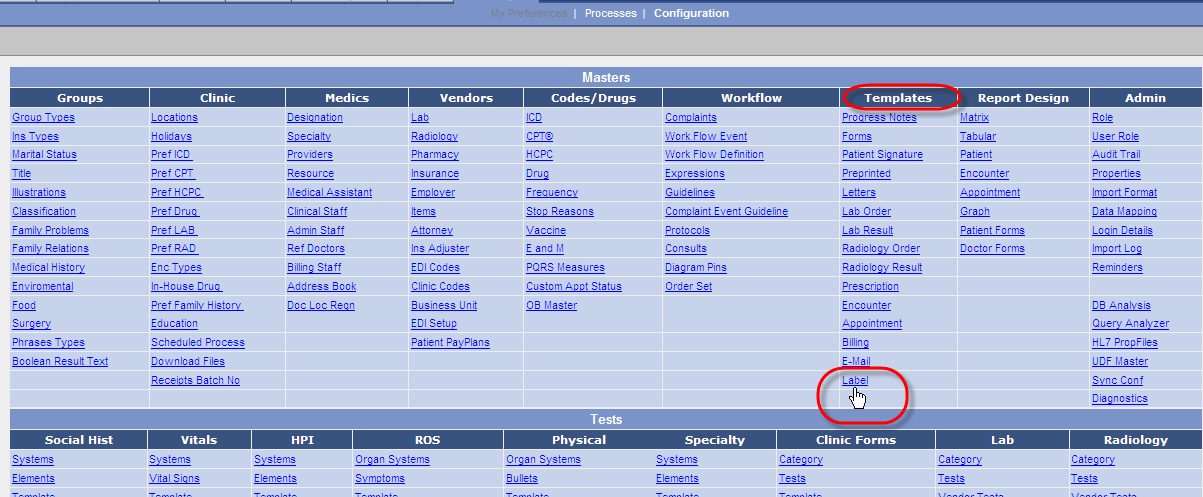
- On click on the Label link, a Template Search Page is available, displaying existing Label templates and the Add New button to define a customized Label Printer template. Refer to the following figure 8.3-2
Figure 8.3-2 : Templates Search page

- Along with template name the sub type is also defined. Respective sub types such as LAB, RAD and PATIENT for Lab, Radiology, and Patient Demographic details respectively, Refer to the following figure 8.3-3
Figure 8.3-3 : Screen displaying Sub Type field
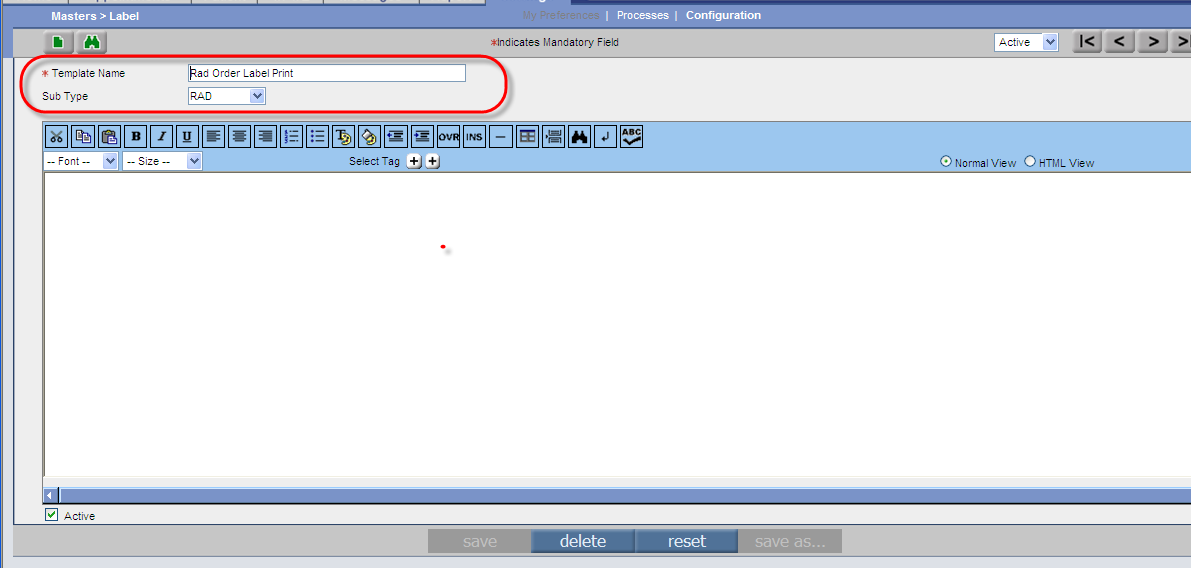
- Templates defined are available for selection at the time of Label Printing i.e. from the Label Printing popup. Refer to the following figure 8.3-4
Figure 8.3-4 : List for existing templates in Template drop-down list
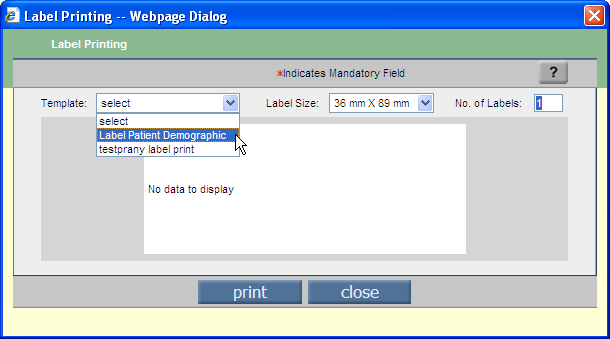
- Label Printer icon is available to print Patient Demographic details, Refer to the following figure 8.3-5
Figure 8.3-5 : Patient Demographic screen displaying Label Printer icon

Note:
- The Label size selected is now available in mm (millimeter)
- At a time, multiple copies of labels can be printed. The No. of Labels field supports maximum of two digit number.
• Label Printer icon is now also available to print Radiology and Patient Demographic details – in extension to the available feature to print Lab details. Refer to the following figure 8.3-6
Figure 8.3-6 : Label Printer icon on CPOE Radiology Order screen

![]() Note:
Note:
• The Label templates defined in the earlier versions that were defined under Lab Order (Settings → Configuration → Lab Order) are now displayed under Label (Settings → Configuration → Label) .
Navigation – GoTo tab: Settings → Configuration → Doctor Forms → Template. On selection of the template through the Section → [+] button , PrognoCIS now displays the CPT codes along with their description under the Label column, Refer to the following figure 8.4-1
Figure 8.4-1 : The screen displaying CPT codes along with the description
Preferred Drug definition now has provision to add dispensable details such as Long Term and PRN to drugs preferred by Clinic and Providers.
Navigation – GoTo tab: Settings → Configuration → Pref Drug link → Clinic Preferred Drug screen → click on![]() the Dispensable button of a particular drug → Dispensable Details popup . Refer to the following figure 8.5-1
the Dispensable button of a particular drug → Dispensable Details popup . Refer to the following figure 8.5-1
and
GoTo tab: Settings → My Preferences
→ Drug link → Preferred Drug for <Provider Name> screen → click on![]() the Dispensable button of a particular drug → Dispensable Details popup . Refer to the following figure 8.5-1
the Dispensable button of a particular drug → Dispensable Details popup . Refer to the following figure 8.5-1
Figure 8.5-1 : Newly added options, Long Term and PRN
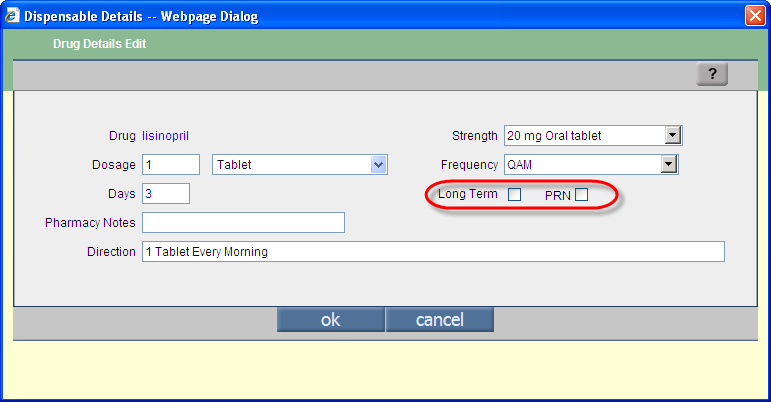
• Preferred Drug Search now considers the existing property, rx.show.inactive.drugs to display list of drugs.
Navigation – Clinic preferred drug list,
GoTo tab: Settings → Configuration → Pref Drug link . Refer to the following figure 8.6-1
Figure 8.6-1 : Clinic Preferred Drug search from Pref Drug link
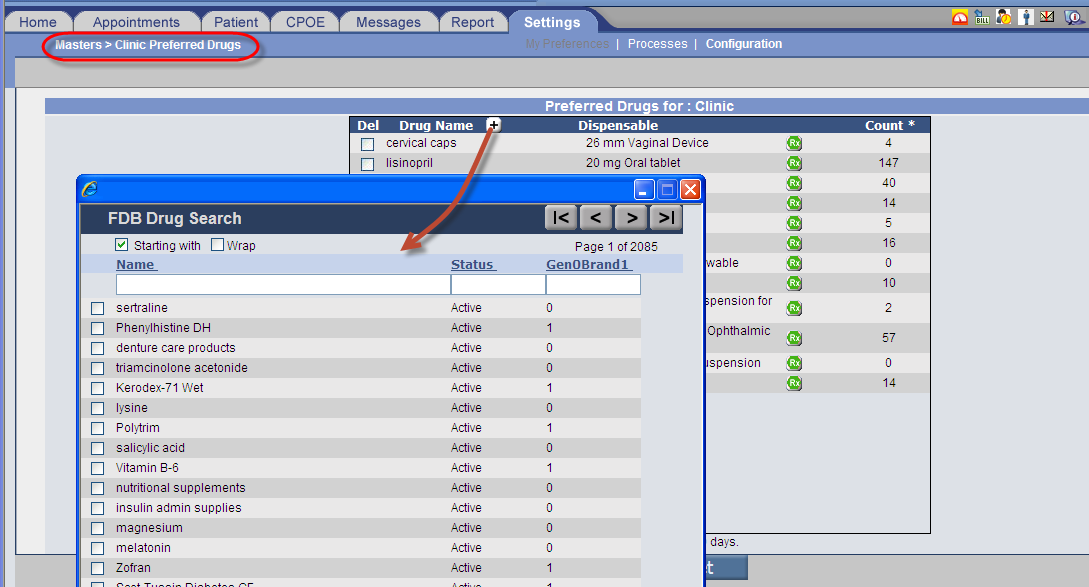
Provider preferred drug list ,
Navigation –GoTo tab: Settings → My Preference → Drug link . Refer to the following figure 8.6-2
Figure 8.6-2 : Provider Preferred Drug Search from My Preference
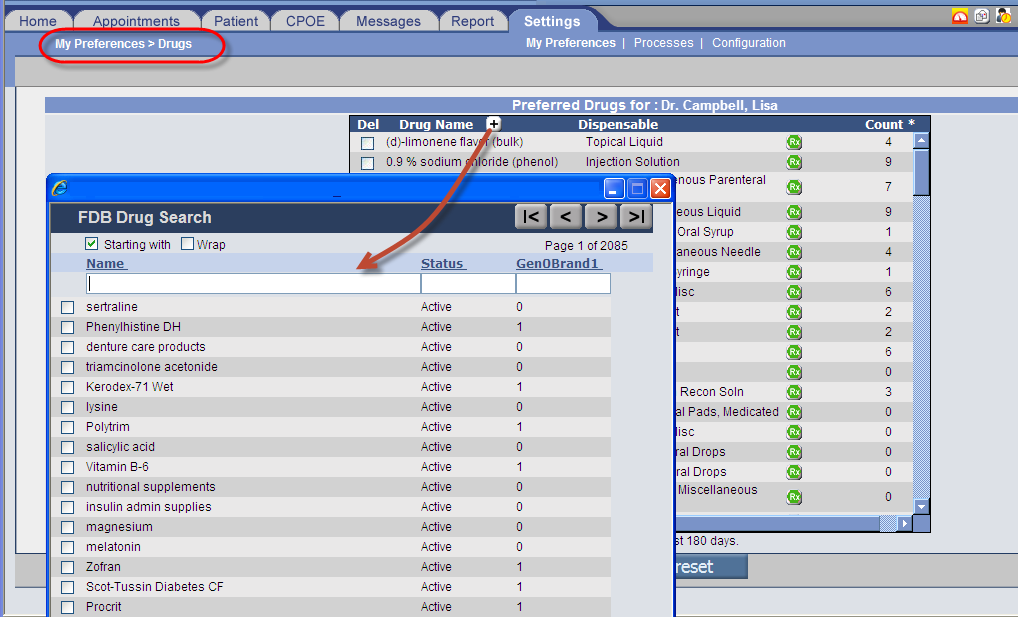
• User can add same drug with multiple strengths in Preferred drug list (Clinic and Provider).
![]() Note:
Note:
• Drug selected from Prescription screen (through Drug drop-down menu) displays the last prescribed details. If a User changes the drug's strength which is available in the Preferred list then changing the drug strength will not auto populate its details.
For Example:
Provider's preferred drug list consists of two drugs with same name but different strengths, Refer to the following table 8.6-1:
Table 8.6-1 : Drugs with details available in the Preferred list fields
| Sr. No. | Drug Name | Strength | Prescribed on | Days |
|---|---|---|---|---|
1. |
Tylenol | 25-500mg oral tablet | 1/1/2010 | 3 |
2. |
Tylenol |
500mg oral capsule | 1/1/2013 | 4 |
On Prescription screen when drug name “Tylenol” is selected for a Patient then the default strength will be “500mg oral capsule” and other field's default values are the ones prescribed on 1/1/2013 and days value will be 4.
Now, suppose if User changes the strength from “500mg oral capsule” to “25-500mg oral tablet” then program will NOT take the other field's default values from the respective entry. In this case other field's values remain unchanged i.e. prescribed on will be 1/1/2013 and days value will remain as 4.
Also, from the Prescription screen if User adds a drug that is not present in the Preferred list then that drug if prescribed is added to the Preferred list.
• In case of duplicate entries, on Save, the duplicate rows are highlighted in yellow and an alert is displayed to User informing about the presence of duplicity.
• Order Set Drug Search now considers the existing property, rx.show.inactive.drugs to display list of drugs.
Navigation – Preferred drug list on Order Set ,
GoTo tab: Settings → Configuration → Order Set link → select OrderSetType as Order Sheet with option as Rx . Refer to the following figure 8.7-1
Figure 8.7-1 : Drug Search from Order Sheet
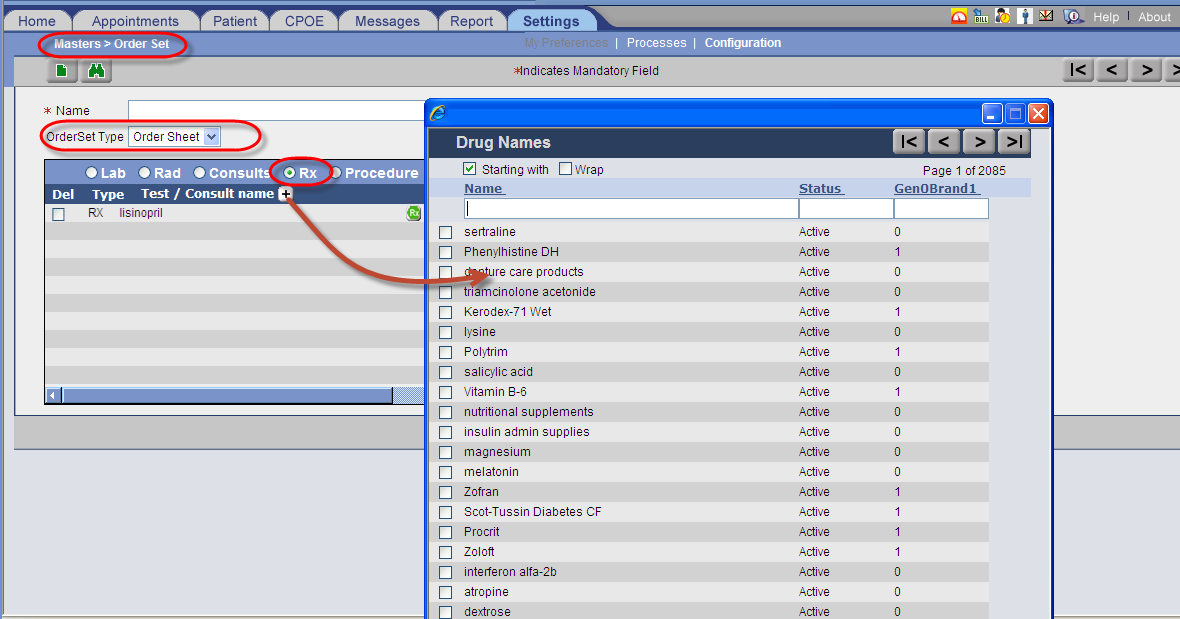
Preferred drug list on Prescription ,
Navigation – GoTo tab: Settings → Configuration → Order Set link → select OrderSetType as Prescription . Refer to the following figure 8.7-2
Figure 8.7-2 : Drug Search from Prescription
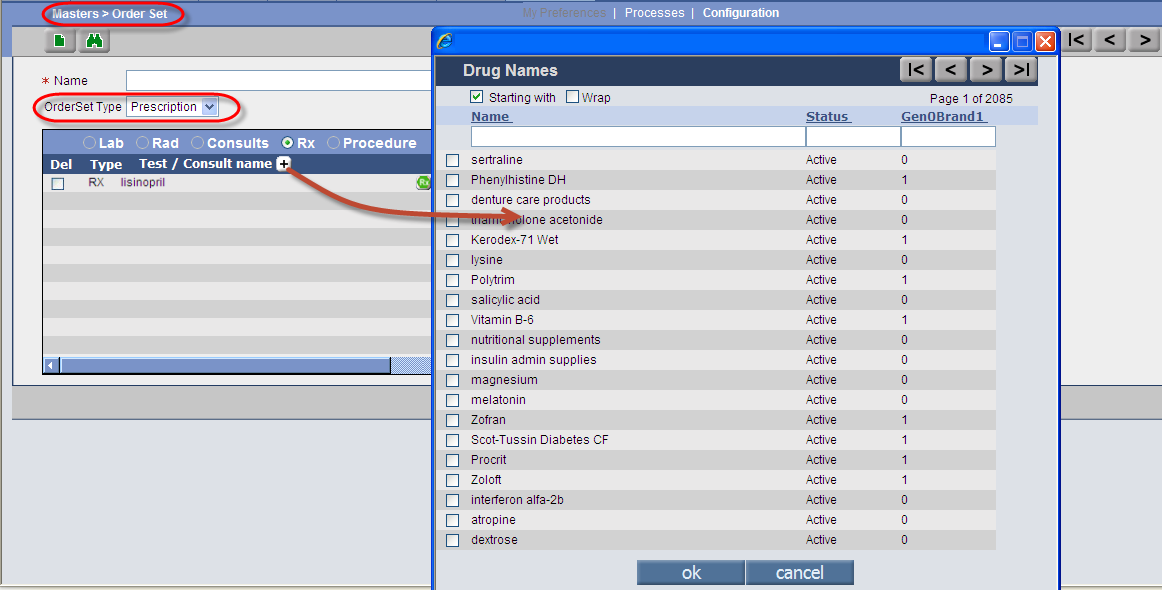
![]() Note: For Prescription the option of eRx is automatically selected.
Note: For Prescription the option of eRx is automatically selected.
PrognoCIS™ consists of 27 events and various locations that invoke sending an email; Refer Table 9.1-1 it is now possible to customize the templates using HTML controls.
Workflow:
- Navigation – GoTo tab: Settings → Configuration → Templates link: Email. Refer to the following figure 9.1
Figure 9.1 : Navigation screen for Templates
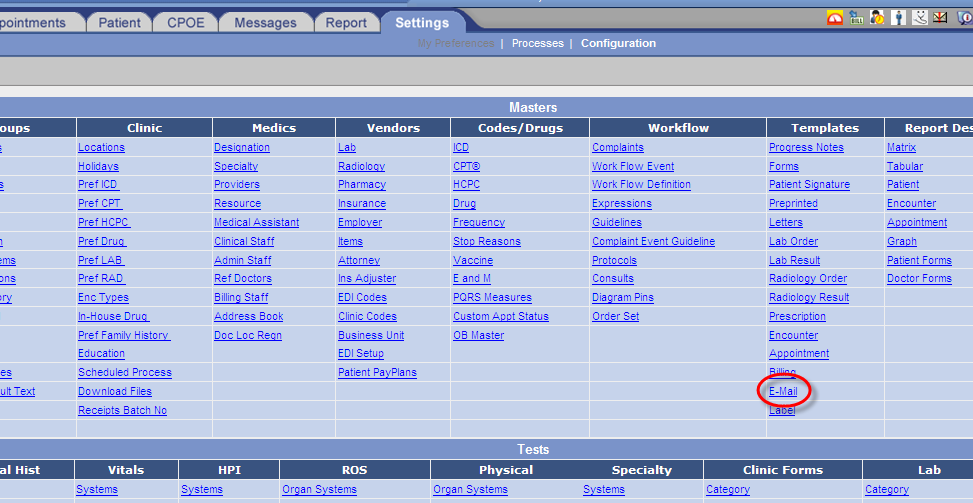
- On click on the Email link, the Email Configurator screen is displayed, Template drop-down displays a list of 27 configurable Email Templates. Refer to the following figure 9.2
Figure 9.2 : list of configurable Email Templates in Template drop-down list
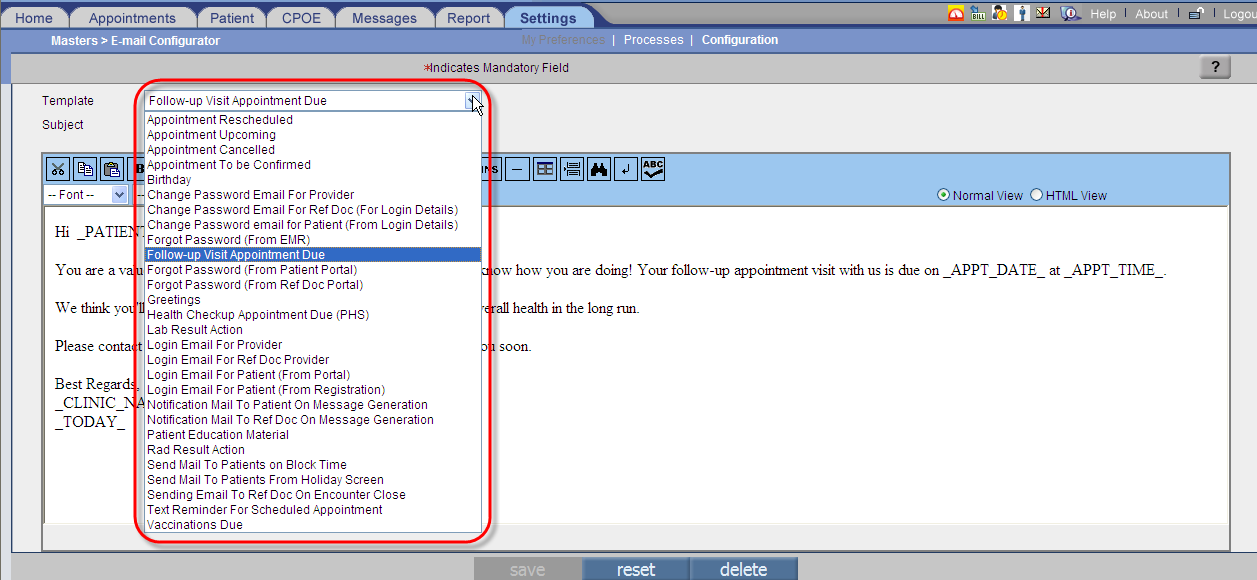
![]() Note: Email templates covering all of PrognoCIS EMR, Patient Portal, and Referring Doc Portal are customized from Email configurator screen.
Note: Email templates covering all of PrognoCIS EMR, Patient Portal, and Referring Doc Portal are customized from Email configurator screen.
- It is possible to enter customized subject line in the Subject field.
- Emails are now composed using HTML controls giving the User a free hand at trying different fonts, size, and color while composing an email, these can be added in addition to the predefined template text . Refer to the following figure 9.3
Figure 9.3 : Screen for e-mail composing
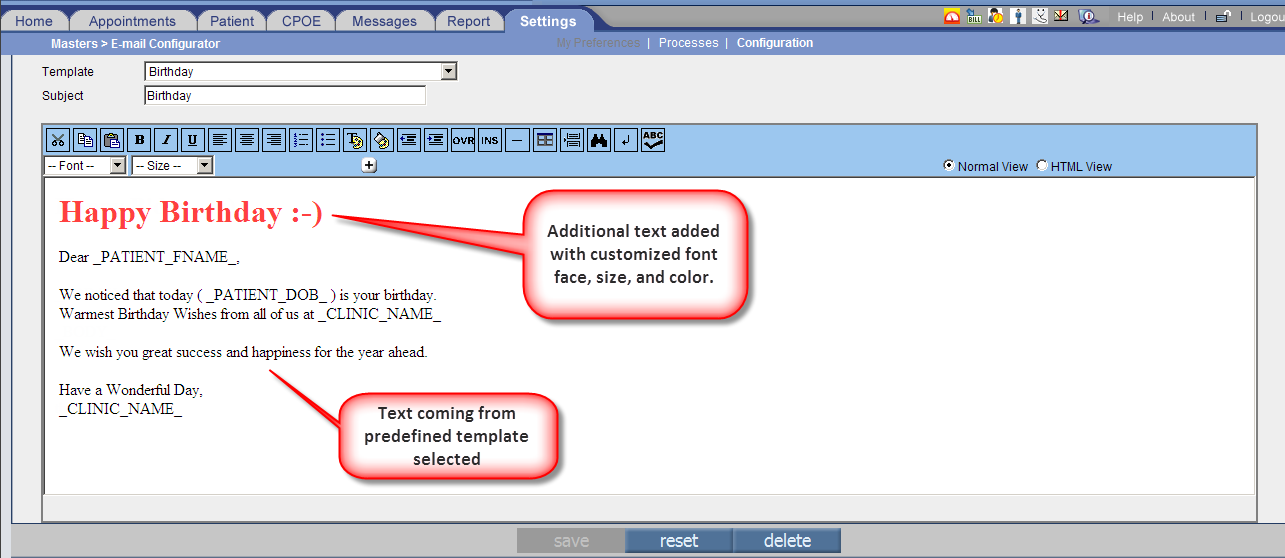
- There are in all Pre-defined tags (15 in all) that are available for Users to select from while composing the email; the button [+] invokes a separate popup namely, Tags . Refer to the following figure 9.4
Figure 9.4 : Pre-defined tags available for composing the email
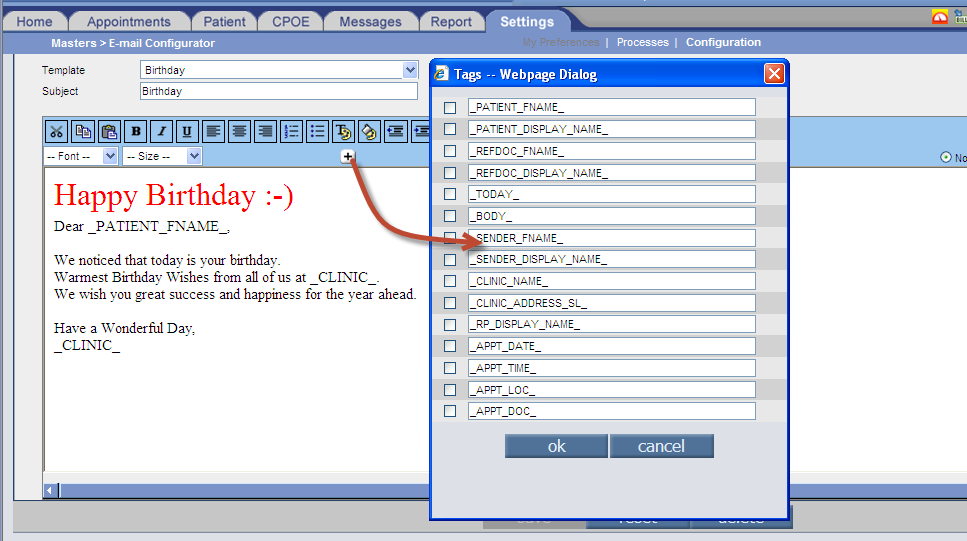
![]() Note:
Note:
The tags used in the template will be parsed to display patient's and clinic's name appropriately once the email is sent.
For example, if tag, _Patient_FName_, _PATIENT_DOB_ and _CLINIC_NAME_ have been used in a template then the email received by the recipient would display Patient's first name, Patient's date of birth, and Clinic name in place of the tags used. Refer to the following figure 9.-5. Also, to refer to all the available tags Refer to Table 9.2
Figure 9.5 : Details of email received by a Patient using the template
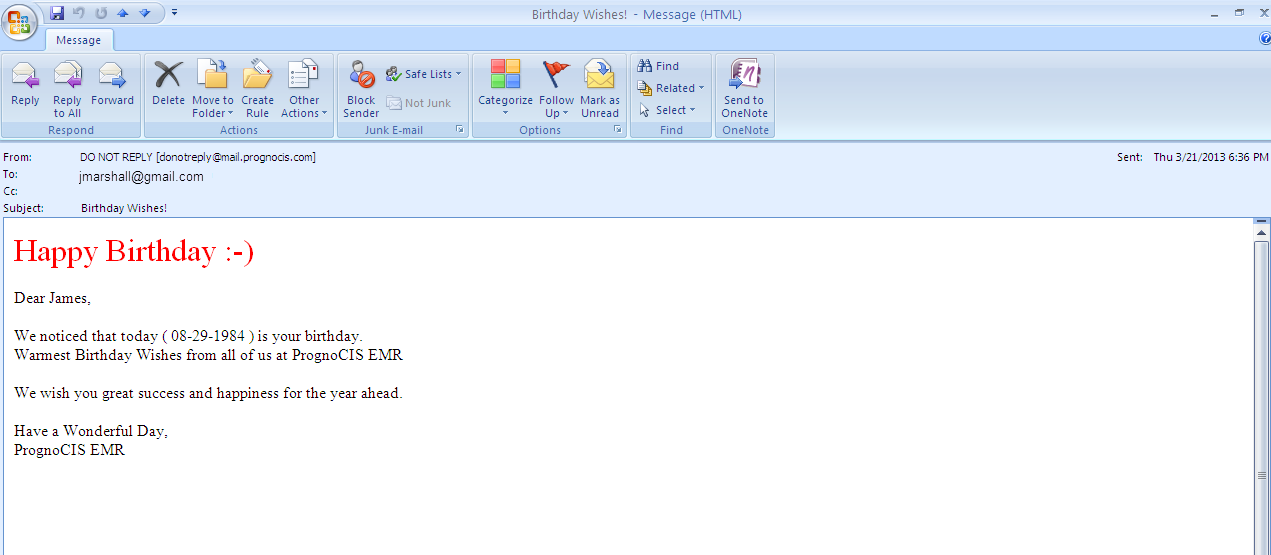
- Following table consists of list of Email templates available for customization: Refer to Table 9.1
Table 9.1 : List of Email templates available for customization
| Nos. | Available Email Templates | Screen Navigation |
|---|---|---|
1. |
Appointment Rescheduled |
Tab: Settings → Processes |
2. |
Appointment Upcoming |
Tab: Settings → Processes |
3. |
Appointment Cancelled |
Tab: Appointments → Schedule → Patient Workflow |
4. |
Appointment To be Confirmed |
Tab: Settings → Processes |
5. |
Birthday |
Tab: Settings → Processes |
6. |
Change Password email for Provider |
Tab: Settings → Configuration → Login Details |
7. |
Change Password email for Ref Doc (For Login Details) |
Tab: Settings → Configuration → Login Details |
8. |
Change Password email for Patient (From Login Details) |
Tab: Settings → Configuration → Login Details |
9. |
Forgot Password (From EMR) |
PrognoCIS™ Home Page |
10. |
Follow-up Visit Appointment Due |
Tab: Settings → Processes |
11. |
Forgot Password (From patient Portal) |
Patient Portal |
12. |
Forgot Password (From ref doc Portal) |
Reference doctor Portal |
13. |
Greetings |
Tab: Settings → Processes |
14. |
Health Checkup Appointment Due (PHS) |
Tab: Settings → Processes |
15. |
Lab result action |
Lab Result Action |
16. |
Login email for Provider |
Tab: Settings → Configuration → Providers |
17. |
Login email for Ref Doc Provider |
Tab: Settings → Configuration → Ref Doctors |
18. |
Login email for Patient (From Registration) |
Tab: Patient → Register |
19. |
Login email for Patient (From Portal) |
Registration mail from Patient Portal |
20. |
Notification mail to Patient on Message Generation | Tab: Message → Compose |
21. |
Notification mail to Ref Doc on Message Generation | Tab: Message → Compose |
22. |
Patient education material |
Encounter → TOC |
23. |
Rad result action |
Radiology Result Action |
24. |
Send mail to patients on Block Time | |
25. |
send mail to patients from holiday screen | Tab: Settings → Configuration → Holidays |
26. |
Sending email to ref doc on Encounter Close |
If ref doc is ON |
27. |
Vaccinations Due |
Tab: Settings → Processes |
- Following table consists of list of Email templates available for customization: Refer to Table 9.2
Table 9.2 : List of Email templates available for customization
| Nos. | Tag Name | Tags |
|---|---|---|
1. |
Patient's First Name |
_PATIENT_FNAME_ |
2. |
Patient's Name for Display |
_PATIENT_DISPLAY_NAME_ |
3. |
Reference Doctor's First Name |
_REFDOC_FNAME_ |
4. |
Reference Doctor's Name for Display |
_REFDOC_DISPLAY_NAME_ |
5. |
Todays Date |
_TODAY_ |
6. |
Text to be displayed on the body of the Email |
_BODY_ |
7. |
Sender's First Name |
_SENDER_FNAME_ |
8. |
Sender's Display Name |
_SENDER_DISPLAY_NAME_ |
9. |
Clinic Name |
_CLINIC_NAME_ |
10. |
Clinic's Address |
_CLINIC_ADDRESS_SL_ |
11. |
Referring Physician Display name |
_RP_DISPLAY_NAME_ |
12. |
Appointment Date |
_APPT_DATE_ |
13. |
Appointment Time |
_APPT_TIME_ |
14. |
Appointment Location |
_APPT_LOC_ |
15. |
Appointment Doctor |
_APPT_DOC_ |
- Following table consists of list of properties that have become obsolete from V2B11 : Refer to Table 9.3
Table 9.3 : List of obsolete propertites
| Nos. | Obsolete Property Tag |
|---|---|
1. |
mail.appt.followup.message |
2. |
mail.appt.followup.subject |
3. |
mail.appt.phs.message |
4. |
mail.appt.phs.subject |
5. |
mail.appt.resch.message |
6. |
mail.appt.resch.subject |
7. |
mail.appt.tentative.message |
8. |
mail.appt.tentative.subject |
9. |
mail.appt.upcomingappt.message |
10. |
mail.appt.upcomingappt.subject |
11. |
mail.appt.vac.message |
12. |
mail.appt.vac.subject |
13. |
mail.birthdate.message |
14. |
mail.birthdate.subject |
15. |
mail.greetings.subject |
16. |
mail.login.message |
17. |
mail.login.subject |
![]() Note: The values that were set in these properties will not be carried forward in the current (V2B11) version.
Note: The values that were set in these properties will not be carried forward in the current (V2B11) version.
• A new value of ‘R’ has been assigned to the existing property, pp.take.appointment, which when assigned displays a button, Request Appointment on Patient Portal – Appointment tab.
• Request Appointment button indicates that Users have provision to request for an appointment from the Clinic and it is at Clinic’s discretion whether to confirm or allow the requested appointment to be taken.
• On click on Request Appointment button, the requested appointment details are displayed under Upcoming Appointment section – with the appointment status as ‘Req'. Refer to following figure 10.1-1 and an email message is sent to the User Role that is defined in the property, pp.appointment.mailto
Figure 10.1-1: The screen displaying Upcoming Appointment section with status 'Req'

• Appointments requested on the Portal are seen by Clinic staff from the Call List found on Appointment schedule screen (from PrognoCIS GoTo tab: Appointment → Schedule screen). A newly added option, ‘Requested’ when selected, displays the list of requested appointments that require confirmation, Refer to following figure 10.1-2
Figure 10.1-2: Option, ‘Requested’ displays the requested appointment list from Appointment Call List
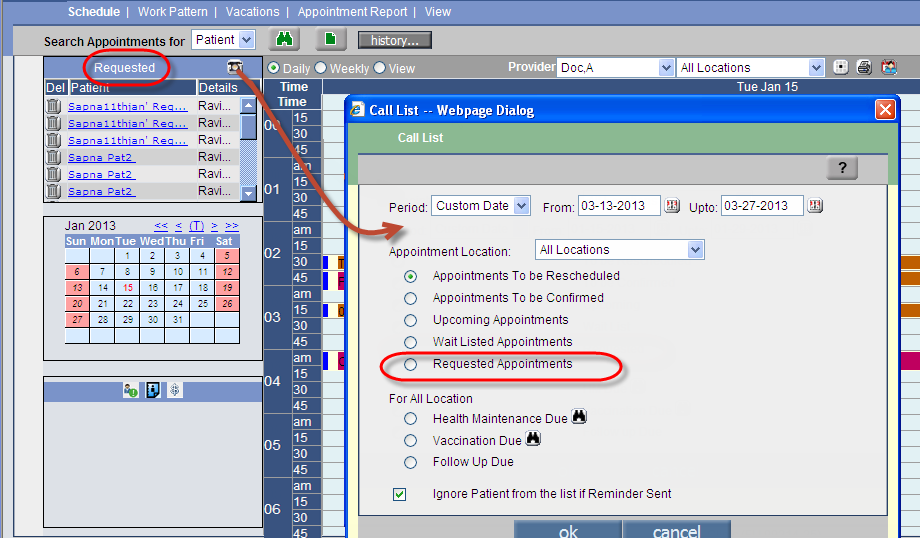
• Clinics have an option to decide which Clinic Locations should be available to Patients on Patient Portal.
• Navigation, GoTo tab: Settings → Configuration → Clinic → Locations
On selection of a particular Clinic location details, an option, Available for appointment for portal available Refer the following figure 10.2-1 is available which makes the Clinic visible on Patient Portal for selection by portal Users. Refer the following figure 10.2-2
Figure 10.2-1: Selecting the Clinic on Patient Portal for location selection
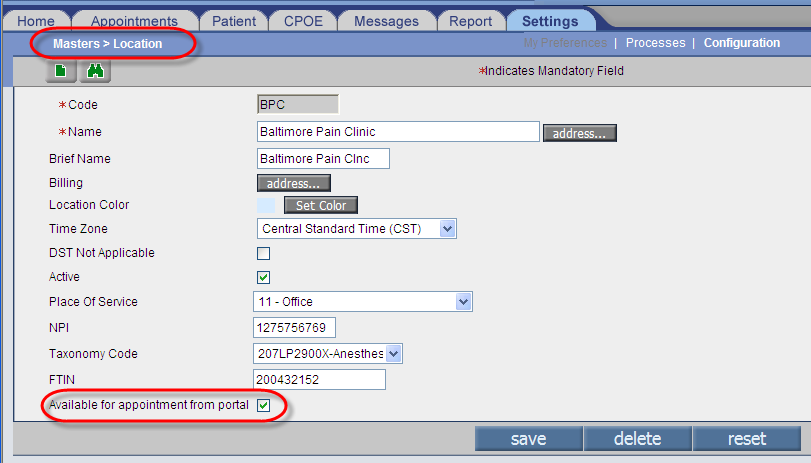
Figure 10.2-2: Appointment screen displaying location selection by portal Users
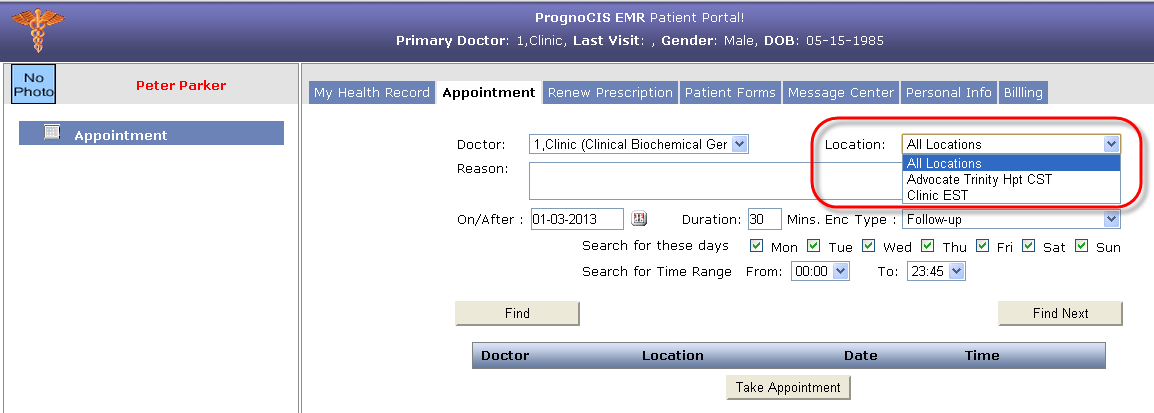
Patients now have the provision to take multiple appointments from portal. Once a User takes an appointment – ‘Req' or otherwise then the appointment details are available under the Upcoming Appointments section and from the appointment scheduler, a Patient is free to take or request further more or multiple appointments.
Patient's photograph is now displayed on User's account on portal (if available). Refer the following figure 10.4-1
Figure 10.4-1: Screen displaying Patient's photograph

![]() Note: If patient's photograph is not available in PrognoCIS™ then “No Photo” image is displayed.
Note: If patient's photograph is not available in PrognoCIS™ then “No Photo” image is displayed.
• Reminders for Follow-up, Vaccination and Health Maintenance that are due are visible on portal (if applicable) for the patient.
• A new icon: ![]() for Patient Reminder is visible on the portal. The icon blinks with the clock image if there is any reminder available for the patient, else the icon appears static.
for Patient Reminder is visible on the portal. The icon blinks with the clock image if there is any reminder available for the patient, else the icon appears static.
• Patient Reminder popup displays the type of reminder (Follow-Up or Vaccination or Health Maintenance); Description describing the reminder; and the applicable due date, Refer to following figure 10.5-1
Figure 10.5-1: Screen displaying Patient Reminder icon
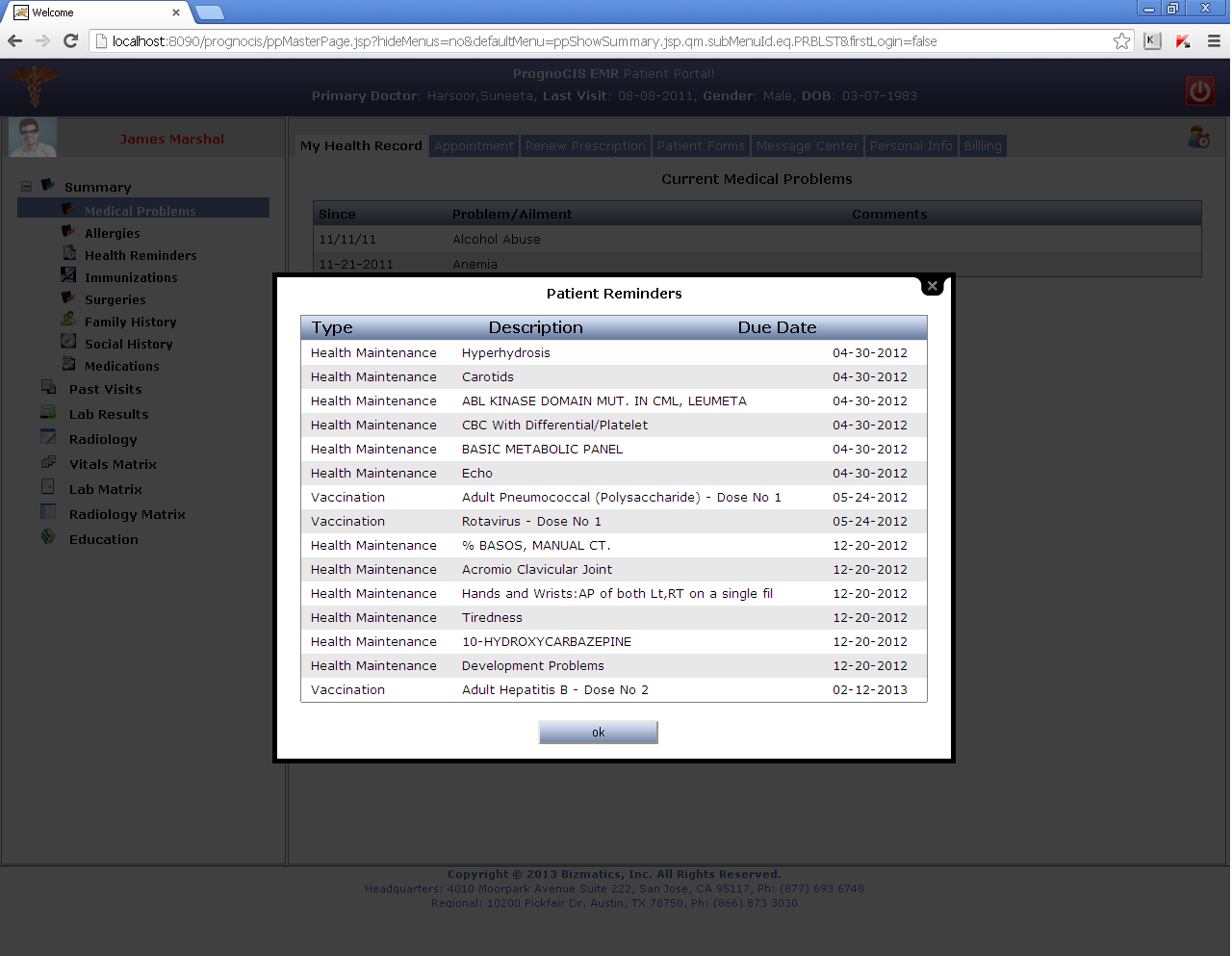
![]() Note: The sort order of the reminders is according to the due date.
Note: The sort order of the reminders is according to the due date.
• Education materials are listed as links; they are URLs, Brochures, and Print materials that have been provided to the patient from PrognoCIS right from patient's first Encounter with the Clinic (using PrognoCIS™).
• The links on click invokes the information in a new browser window or tab.
![]() Note: There will be no hyperlink, if no attachment found for the given education material. (Instead of displaying java script alert “No attachment found” on click of the link).
Note: There will be no hyperlink, if no attachment found for the given education material. (Instead of displaying java script alert “No attachment found” on click of the link).
• Provision to display Clinic defined Disclaimer is displayed to the Users who logon first time on Patient portal. The feature is property based and depends on the property, pp.show.disclaimer . If the property is set to ‘Y' then the Disclaimer is displayed to the User and the User has to accept it to login to the portal.
• The customized contents of Disclaimer have to be added to an HTML file (Disclaimer.html) found under Patient Portal property folder, patientportalprops (path: pronocis\Data Files\patientportalprops), Refer the following figure 10.7-1
Figure 10.7-1: Screen displaying Clinic defined Disclaimer
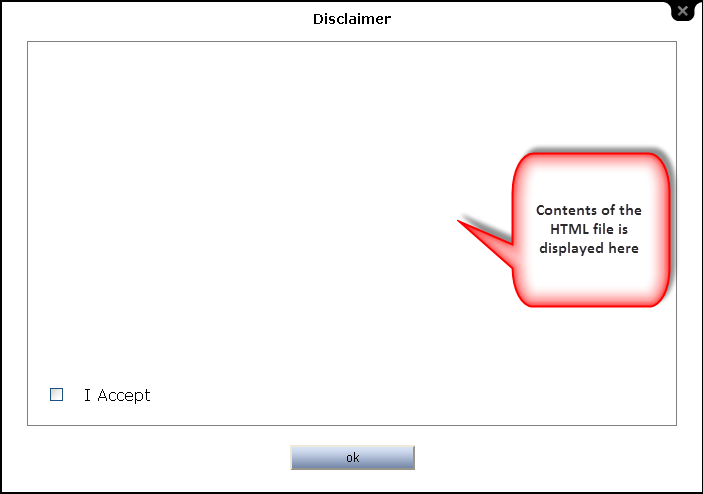
Drug names on Prescription are now displayed along with its strength and direction, Refer the following figure 10.8-1
Figure 10.8-1: Screen displaying Prescription with its strength and direction

Billing information can be displayed on Portal. Three important information of Patient such as,
a) Patient Outstanding, Refer the following figure 10.9-1
b) Patient Payments, Refer the following figure 10.9-2
c) Statements, Refer the following figure 10.9-3
Figure 10.9-1: Screen displaying Patient Outstanding

Figure 10.9-2: Screen displaying Patient Payments details

Figure 10.9-3: Screen displaying statement of billing

• Resolution compatibility or multiple resolution support achieved by PrognoCIS™ is now further enhanced to cover height region of computer screens that are greater than 1024 x 768 (approximately 1289 x 1024).
• A larger section of the height region that was earlier left out as whitespace has now been appropriately covered. Refer the following figures 11.1, 11.2
Figure 11.1: Screen with white space
Figure 11.2: Screen without white space
At the time of HL7 import, the PD1 segment details (which includes the External ID + First Name +Last Name of Provider) available is first matched with Provider details within PrognoCIS™, if a match is found then the imported Provider name obtained from PD1 segment is added to patient's Primary Care physician details. And if the PD1 segment details do not match with available Providers in PrognoCIS™ then it is added into PrognoCIS™ as ‘Reference Doc' and attached to respective patient's details.
Modifiers that are associated to CPT/HCPC automatically get added to Assessment screen. If there are modifiers associated to CPT/HCPC master (GoTo tab: Settings → Configuration → CPT/HCPC) and on specialty template (GoTo tab: Settings → Configuration → Specialty Templates), then the preference will be given to specialty template and accordingly codes get added to the assessment screen.
Navigation: GoTo tab: Patient → Encounter → TOC → Encounter Close, in procedural templates of Doctors form if any mandatory tests are unanswered then on Encounter close PrognoCIS displays an alert, Refer the following figure 14.1
Figure 14.1: Encounter Close screen with mandatory test alert popup

For Tabular Reports:
A. Following are the changes done in Tabular Report screen: Refer the following figure 15.1
Navigation GoTo tab: Reports → Tabular
• The Tabular Report Search popup now consist of two individual tabs namely, My and All . Refer the following figure 15.1
Figure 15.1: Tabular Report Search popup displaying My and All report tabs
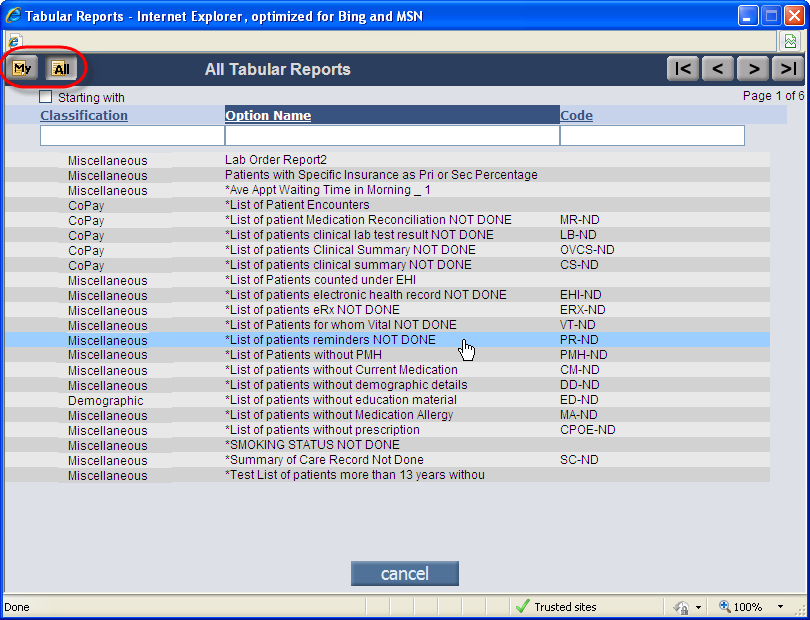
• The ‘All’ tab consists of all the available Reports created and present in the system , Refer the following figure 15.2
Figure 15.2: The ‘All' tab displaying all the tabular reports available in the system

• The ‘My’ tab consists of reports that have been selected and saved by User and is part of My Report, Refer the following figure 15.3
Figure 15.3: The ‘My' tab displaying the preferred tabular reports as maintained by the User
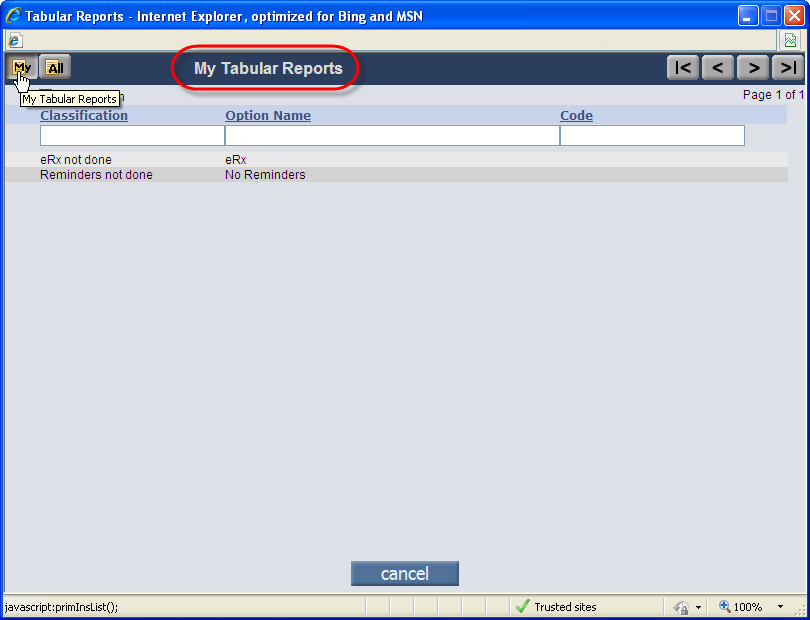
• Steps to create My Report:
- GoTo tab: Reports → Tabular → Tabular Reports Search
- Select an existing Tabular Report that is required to be added in preferred list of My Reports; the tabular report details screen is displayed, Refer the following figure 15.4
Figure 15.4: Save As icon is available to save the current report to My Reports
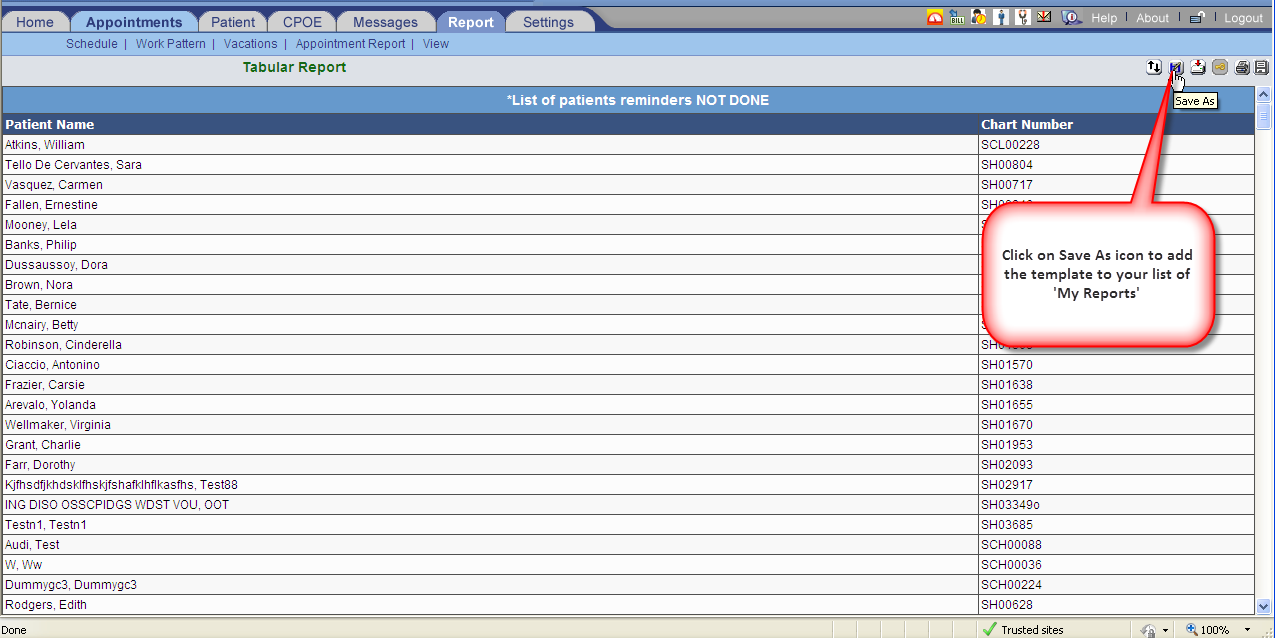
- From the Save As popup, User can give customized Option Name and Classification to be saved in his/her My Report list, Refer the following figure 15.5
Figure 15.5: Save As popup
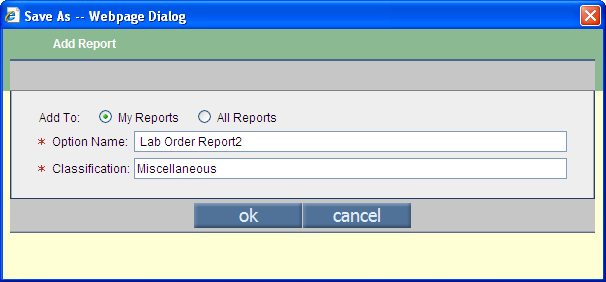
- On click on OK the My Reports list is appended, Refer the following figure 15.6
Figure 15.6: Appended report as displayed on ‘My Tabular Reports' popup
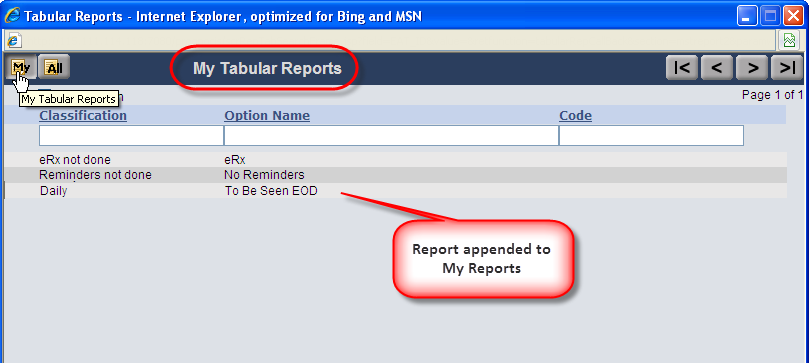
B. Following are the changes done in Report Definition search popup : Refer the following figure 15.7
Navigation GoTo tab: Settings → Configuration → column: Report Design → link: Tabular
• A new tab: My is added that displays User preferred list of Tabular reports. Notice the change in look and feel of the tabs ( All and My ).
Figure 15.7: Tabular reports search popup
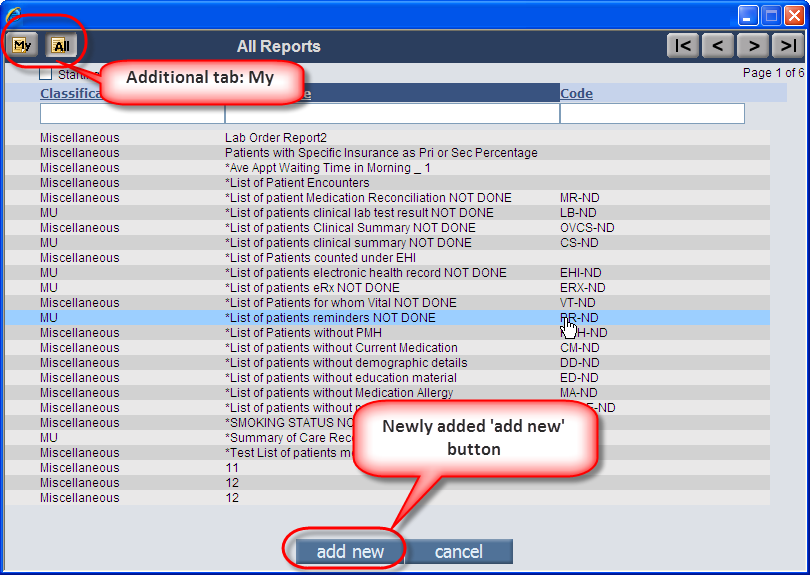
• A new button: add new has been provided on the Reports' search popup that allows Users to create and add newer Report design or definition.
![]() Note: The Reports added from tabs, i.e. either ‘My' or ‘All' are displayed under respective tabs.
Note: The Reports added from tabs, i.e. either ‘My' or ‘All' are displayed under respective tabs.
C. Following are the changes done in Report Definition screen: Refer the following Table 15.8
• If a ‘My Report' is searched and opened then a text, ‘My Report' in red is displayed on the report, indicating that the report definition is that from My Reports list – the text would be absent otherwise.
• The Classification field is now a mandatory field.
Figure 15.8: Changes done on Report Definition screen
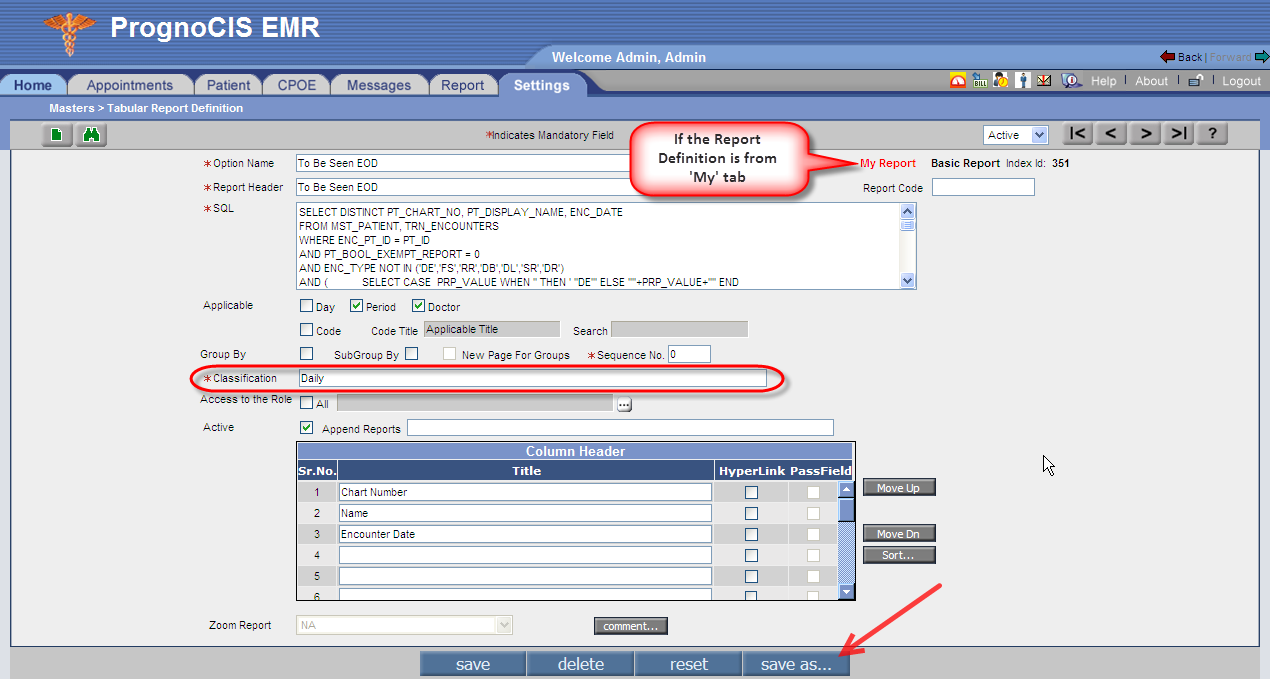
• The Save As button invokes enhanced version of the Add Report popup. Refer to figure 15.9
Figure 15.9: Save As popup displays the options My Reports and All Reports
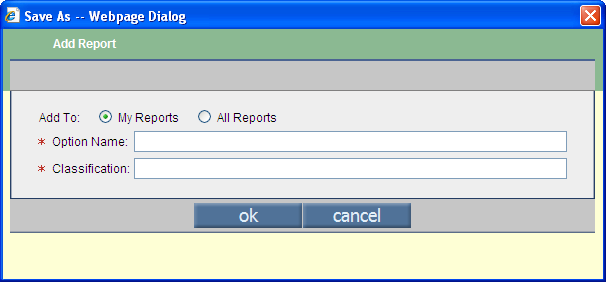
![]() Note:
Note:
• Save As popup adds the currently selected report definition in any one of the option that has been selected (My Reports or All Reports).
• In Edit mode, the fields, Option Name and Classification automatically has the values from the report definition, it can be edited and saved by the User. Refer to figure 15.10
Figure 15.10: While editing a pre-existing report definition, the ‘Save As' popup pre-loads or populates the values of the fields, ‘Option Name' and ‘Classification'
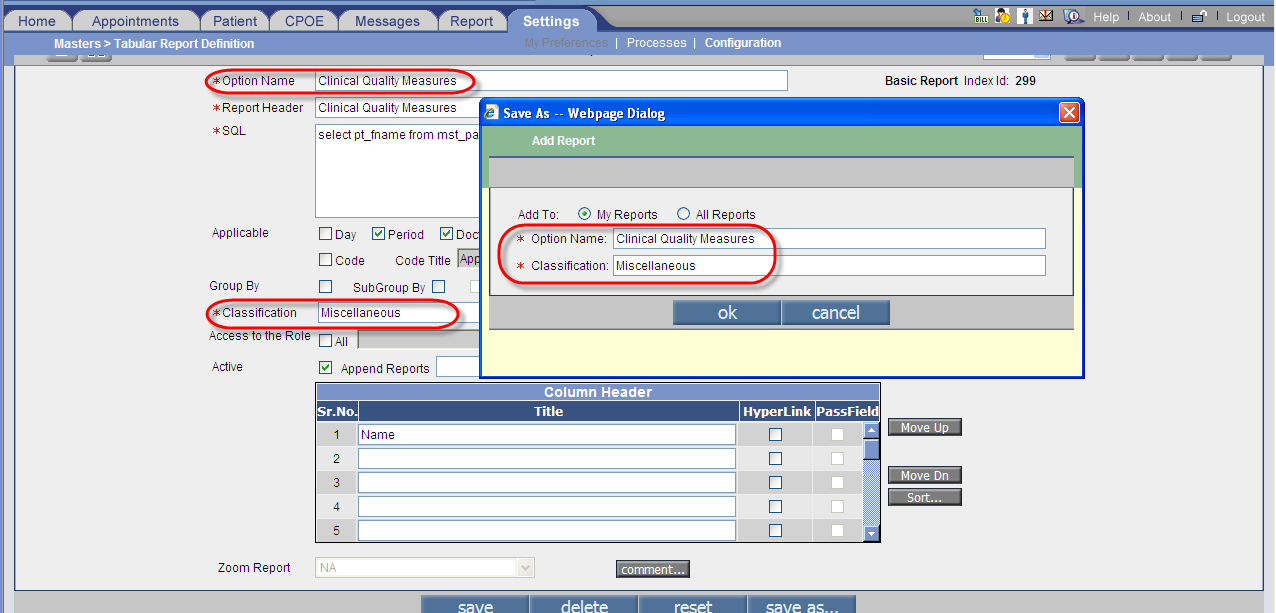
It is possible to send Provider's State License details in eRx. According to the requirement of Clinics, PrognoCIS implementers can change the status of MED_BOOL_SEND_REGN flag.
Following table displays a list of newly added icons in PrognoCIS™ from the current version: Refer the following Table 17.1
Table 17.1 : list of newly added icons in PrognoCIS™
Nos. |
Icon |
Name |
Description /On screen path |
|---|---|---|---|
1. |
|
Appointment History |
Tab: Patient → Register |
2. |
|
Case Management |
Tab: Patient → Register |
3. |
|
Insurance |
Tab: Patient → Register |
4. |
|
Patient Reminder |
Patient Portal |
5. |
|
Login Info |
Tab: Patient → Register - Patient portal should be ON for the patient. |
6. |
|
Legal |
Tab: Patient → Register |
7. |
|
Deny Access |
Tab: Patient → Register |
8. |
|
Patient Billing Notes |
Tab: Patient → Register |
9. |
|
Patient Alert |
Tab: Patient → Register |
10. |
|
Current Encounter |
Tab: Patient → Register |
11. |
|
Label Printer |
Tab: Patient → Register |
12. |
|
Card Scan |
Tab: Patient → Register |
| 13. |
|
Patient Notes |
Tab: Patient → Register Icon in red signifies presence of Patient Notes. |
| 14. | Mark Arrived | Tab: Appointment → Schedule | |
| 15. |
|
Patient Pharmacy |
Tab: Patient → Register and Patient Encounter → TOC → Prescription screen → Pref Pharmacy button → Pref Pharmacy Search popup |
| 16. |
|
Clinic Pharmacy |
Patient Encounter → T OC → Prescription screen → Pref Pharmacy button → Pref Pharmacy Search popup |